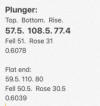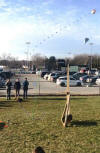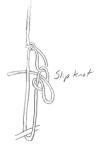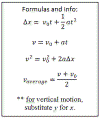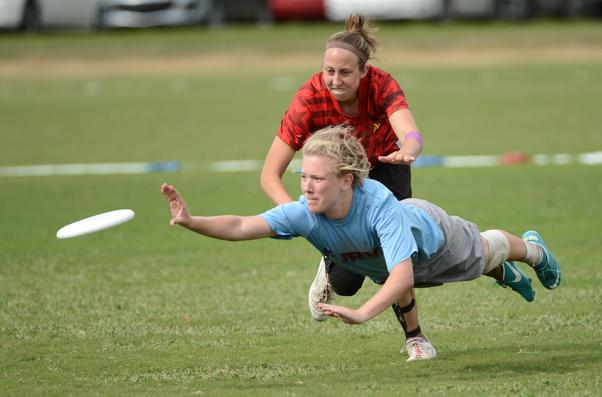 Class
86.5 Friday, 6/7/19
Class
86.5 Friday, 6/7/19Warm-Up:
1. How does a "Frisbee" work?
2. Why is "Frisbee" in quotation marks?
3. Typical sport discs tend to roll over in the air. Which way do they roll over?
4. What causes a disc to roll over and how can you prevent it?
Today:
-
Final Exam Stuff:
-
Exam review packet #1 Answers Solutions that were missing from "answers"
-
You can have handwritten notes (written by you) on both sides one 8.5" x 11" sheet of paper.
-
Don't forget that you have to stay for the full 2 hours. Bring something to do.
-
Homework:
-
Prepare for the final exam.
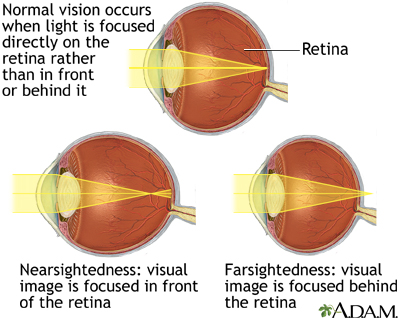 lass
86 Thursday, 6/6/19
lass
86 Thursday, 6/6/19Warm-Up:
1. Why can't humans see clearly under water?
2. Guess which condition (on the right) makes it easier to see clearly under water?
3. Goggles and masks can be used to see clearly under water, but they distort the observed heights of objects. Do they magnify or reduce? Why?

Today:
-
Return things
-
Quiz points back for the wrong speed of light on problem #1.
-
Exam Review -- note the additions below of some solutions and sound/waves material.
-
Physics Coffee House. You may perform a song on an instrument for extra credit -- up to 3% added to Sound and Waves test or Final Exam. Food, drink, and instruments from home are welcome. Some songs that go well with the ukulele
-
Final Exam Stuff:
-
Exam review packet #1 Answers Solutions that were missing from "answers"
-
You can have handwritten notes (written by you) on both sides one 8.5" x 11" sheet of paper.
-
Don't forget that you have to stay for the full 2 hours. Bring something to do.
-
Homework:
-
Prepare for the final exam.
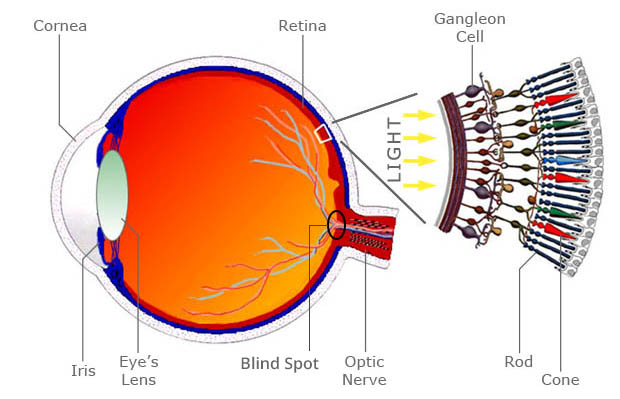 Class
85.5 Wednesday, 6/5/19
Class
85.5 Wednesday, 6/5/19Warm-Up:
1. What would you guess is the approximate focal length of the human eye?
2. Does that focal length change? Explain.
3. Why do we have a blind spot?
4. How can you "find" your blind spot?
5. How does a pinhole camera work?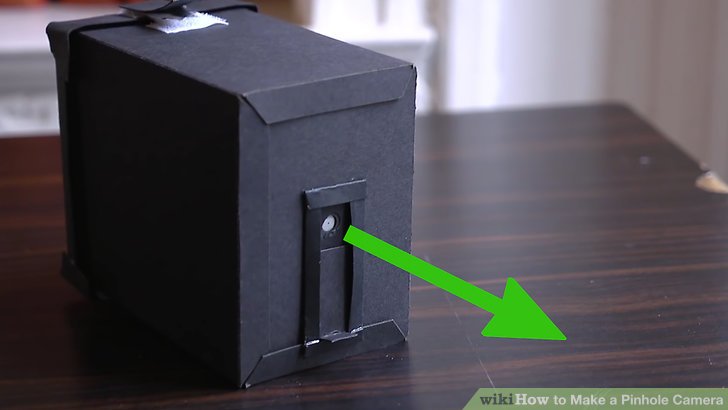
6. Regarding the lower diagram on the right, why is it necessary
for the rays to cross in order to form an image?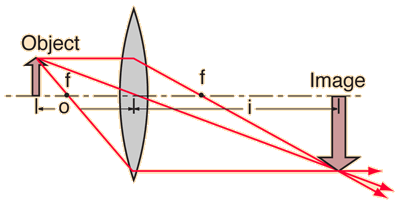
Today:
-
Quiz for some
-
Assignments have been graded, but some grades have not yet been entered (quiz, projects, recent homeworks). I plan to enter those tonight.
-
Some of you have not submitted the project.
-
Tomorrow -- Review and Physics Coffee House. You may perform a song on an instrument for extra credit -- up to 3% added to Sound and Waves test or Final Exam. Food, drink, and instruments from home are welcome.
-
Final Exam Stuff:
Reading:
Homework:
-
Prepare for the final exam.
Warm-Up:
primary and secondary rainbows
4. What is the connection between these pictures and refraction?


Today:
-
Quiz
-
Tomorrow -- Be ready to ask questions about the exam. Hopefully I will have everything graded.
-
Thursday? -- last full class
-
Final Exam Stuff:
Reading:
Homework:
-
Prepare for the final exam.
 Class
84.5 Monday, 6/3/19
Class
84.5 Monday, 6/3/19Warm-Up:
The index of refraction (n) of a substance varies with the wavelength of the waves passing through the substance. This phenomenon causes dispersion, which is the separation during refraction of light rays of different color.
1. What are the colors of visible light, in order of wavelength?
2. If n decreases with increasing wavelength, where will the different colors emerge from this prism?
Scattering is the phenomenon whereby light "bounces off" of particles (e.g. N2 molecules, ice crystals, and smoke) in the sky. Shorter wavelengths of light are more susceptible to scattering than longer wavelengths.


2. Why is the sky blue?
3. Why are sunsets red?
Today:
-
Check/review homework: Optics practice quiz Real answer to problem #4.

-
Return papers
-
Discuss Physics Coffee House on Thursday
-
Final Exam Stuff:
-
Questions about the final exam?
Reading:
Homework:
-
Prepare for the final exam.
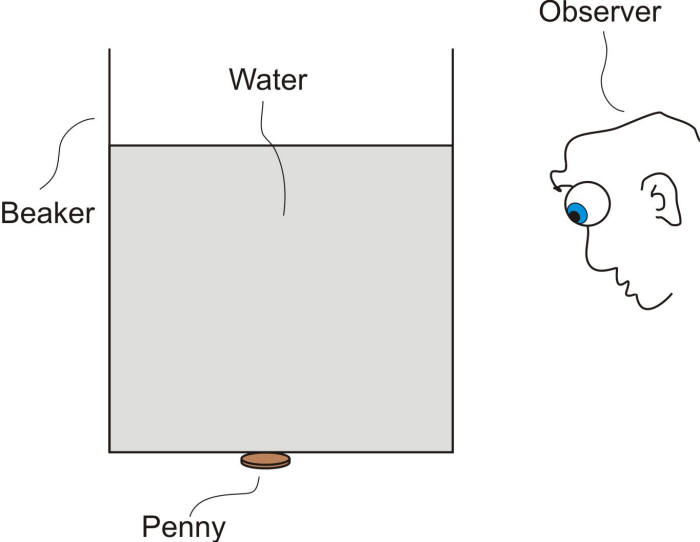 Class
84 Friday, 5/31/19
Class
84 Friday, 5/31/19Warm-Up:
1. Why can't the observer see the penny? (and why can't you see the fish in the tank in the back of the room?)
2. How can we make the penny or the fish visible by adding just one component to the system?
Today:
-
Final Exam Stuff:
-
Solar Activities -- Complete the questions/problems on this sheet -- Focusing light with lenses and mirrors
-
Eat pizza -- hopefully
-
Find focal lengths of convex lenses
-
Find the focal length of a parabolic mirror
-
Design some solar oven reflectors.
-
Reading:
Homework:
-
Prepare for the final exam.
Warm-Up:
Fred is conducting a laser experiment on a very, very, very fast train. He attaches a mirror to the roof of the train car and shines a quick pulse of laser light directly upward at the mirror. Hank is standing still outside the train. The train car is made of glass, so Hank can see the whole thing.
The pulse of laser light goes up, reflects off of the mirror, and then goes back down to the floor. There's enough dust in the air to make the laser pulse visible.
1) If Fred and Hank were to draw the laser pulse's "flight path" (as each of them sees it), what would each of them draw?
2) Who would see light travel a greater distance?
3) Assuming that the speed of the laser light is the same for both observers, who sees it travel for the longest amount of time?

4) Does the boy's bathroom mirror flip
images?
Today:
-
Return tests.
-
Check/Review Homework Practice (with answers) -- Ch 25.3-25.4
-
Final Exam Stuff:
-
Tomorrow -- solar cooking (hopefully -- depends on the weather) and burning things with lenses and mirrors. Bring your sunglasses and maybe some sunscreen. You can also bring a pizza topping or something else to cook.
Reading:
Homework:
-
None
 Class
83 Wednesday, 5/29/19
Class
83 Wednesday, 5/29/19Warm-Up:
If look in a mirror while wearing a shirt that says "shirt," the image will appear flipped. Across which mirror plane will it appear to have been flipped? Why that one? Why not some other mirror plane?
Today:
-
Test takers start in the back and then switch to the front during lab.
-
Check/Review Homework
-
A few more sound things:
-
What happens when you play a violin A string and an E string that are not quite in tune?
-
Harmonics played on a violin (video)
-
Harmonics played on a flute (video)
-
-
Refraction and Total Internal Reflection Notes: Chapter 25.3-25.4 Filled-In Notes
-
Final Exam Stuff:
Reading:
Homework:
-
If your instrument project is not complete, insert a slide at the beginning that says "Do Not Grade." You'll have a zero, but there won't be a permanent grade deduction for one week. After midnight tonight, you'll lose 10% for lateness.
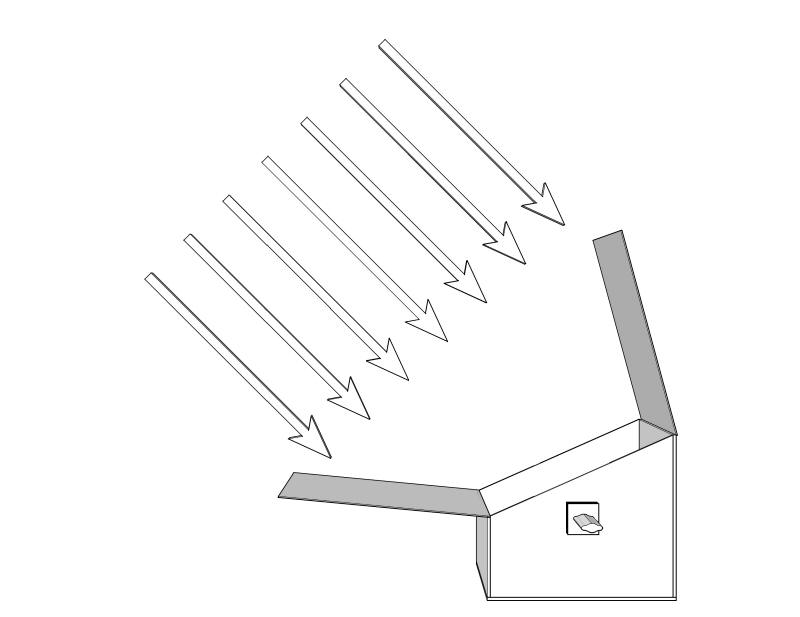 Class
82.5 Tuesday, 5/28/19
Class
82.5 Tuesday, 5/28/19Warm-Up:
The diagram on the right shows a solar oven with two reflectors. The arrows represent the paths of incoming rays of sunlight.
1. What is the purpose of the reflectors?
2. Which reflector is angled correctly?
3. Which rays will be reflected into the box? How can you tell?
4. Why does the solar oven need a glass lid?
Today:
-
Doppler Challenge -- Group Quiz!
-
Geometric Optics -- law of reflection
-
Practice
-
Final Exam Stuff:
Reading:
Homework:
-
If your instrument project is not complete, insert a slide at the beginning that says "Do Not Grade." You'll have a zero, but there won't be a peranent grade deduction for one week. After midnight tomorrow, you'll lose 10% for lateness.
Warm-Up: No Warm-up. Test today.
Today:
-
Test
Reading:
Homework:
-
Sound and waves test tomorrow
-
If your instrument project is not complete, insert a slide at the beginning that says "Do Not Grade." You'll have a zero, but there won't be a peranent grade deduction for one week. After midnight on Wednesday, you'll lose 10% for lateness.
-
Doppler Challenge on Tuesday -- for extra points added to the project. Listen to three recordings of speeding cars and calculate their speeds. You may use your instrument, your ears, a calculator, paper, and pencil.
Warm-Up:
The diagram below shows top views of the same boy looking into mirrors. On the right, the mirror is a simple flat mirror. On the left, the mirror is two separate mirrors arranged at right angles. The boy has one blue eye and one green eye.
When he looks in the mirrors, where will his blue eye appear to be? Why?

Today
:-
Chapter 16-17 4 minute drill Solutions
-
What's on the test:
-
- Old notes -- Notes: Wave and Music theory relating to fret calculations -- and fret practice -- shorten to focus only on fundamental Filled-in notes
- New notes -- Sound and Waves Notes, Part 2 Filled-in version
- Calculating the velocity of sound, given the temperature.
- A problem relating to calculating the distance of a fret from the nut on an instrument with a given string length.
- A format similar to this... Sound and Waves Practice Test. Solutions
- 4 minute drill Solutions
-
Reading:
Homework:
-
Sound and waves test tomorrow
-
If your instrument project is not complete, insert a slide at the beginning that says "Do Not Grade." You'll have a zero, but there won't be a peranent grade deduction for one week. After midnight next Wednesday, you'll lose 10% for lateness.
-
Doppler Challenge on Tuesday -- for extra points added to the project. Listen to three recordings of speeding cars and calculate their speeds. You may use your instrument, your ears, a calculator, paper, and pencil.
Warm-Up: None
Today
:-
Work time -- see previous classes for information
Homework:
-
Sound and waves test on Friday
-
Instrument Projects are due by midnight tonight. If your project is not complete, insert a slide at the beginning that says "Do Not Grade." You'll have a zero, but there won't be a peranent grade deduction for one week. After 1 week, you'll lose 10% for lateness.
-
Quiz corrections for the magnetism quiz are due today.
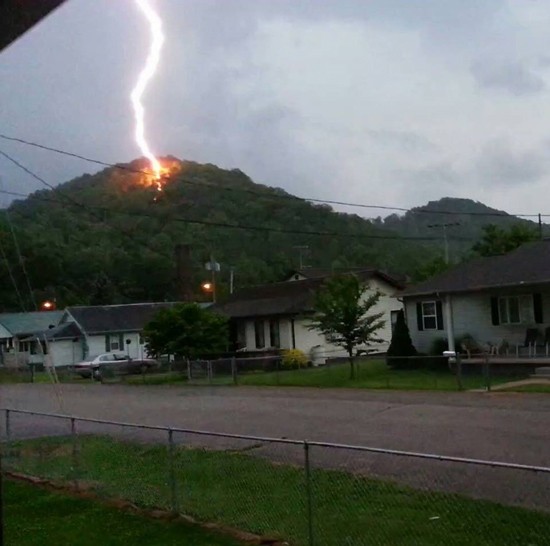 Class
80.5 Monday, 5/20/19
Class
80.5 Monday, 5/20/19Warm-Up:
1. If you see lightning strike a point 1 mile away, how long can you expect to wait before you hear thunder?2. As the sound of lightning travels to the observer, what wave properties (if any) change? Wavelength? Frequency? Period? Amplitude? Speed?
3. 7/8 onlyHow can you write a simple song (that sounds like a song)?
Today
:-
7/8 -- Check/review homework that was due last class. Sound and Waves Practice Test. Solutions (except last problem) -- 40.4m/s. Assuming that the bridge-to-nut distance for this ukulele
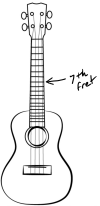 is 40cm, what how far should the 7th fret be placed from the nut?
is 40cm, what how far should the 7th fret be placed from the nut?

-
Both classes -- Instrument Project work time
Music and Ukulele Info/links:
-
Good source for ukulele chords -- Ukutabs.com
-
Some simple songs -- 4 chords or fewer: She Will Be Loved, Folsom Prison Blues, Knockin on Heaven's Door, I'm Yours, Wagon Wheel, Viva La Vida, Free-Fallin (fast chord changes), The Joker, Have It All, Yellow (Cold Play -- one extra chord at very end), Riptide, Happy Birthday, Radioactive, Smells Like Teen Spirit, Somebody That I Used To Know
-
String Mass/Length Ratios (for string tension slide) Don't forget to estimate stretch:
-
100# line -- frets (0.00075kg/m),
-
80# line -- C string (0.00059kg/m),
-
60# line -- E string (0.00031kg/m), 4
-
0# line -- G and A string (0.00026kg/m).
-
-
One way to write a simple song:
-
Find a chord progression that you like
-
Play the chord progression in the key of C
-
Add a melody using mostly the notes that are in the chords (your ear might help you do this without really thinking about the notes)
-
You can record a chord progression in audacity by playing it on the Virtual Piano and using the WASAPI audio host setting. Export the progression and then play it as a loop while you try out melodies along with it.
-
-
Chord progressions:
-
Popular chord progressions: 1-6-4-5, 1-5-6-4...
-
C major chords finger positions, corresponding to chords 1-6 in the chart above.
-
Homework:
-
Sound and waves test on Friday, May 24th.
-
Instrument Projects are due on Wednesday.
-
Quiz corrections for the magnetism quiz are due on Wednesday.
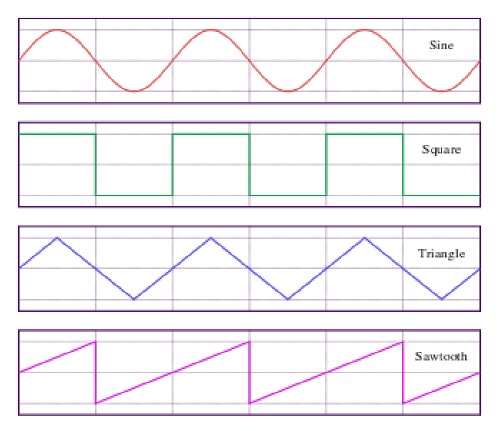 Class
80 Friday, 5/17/19
Class
80 Friday, 5/17/19Warm-Up:
1. What do the waves on the right sound like? link won't work on school wifi
2. How many of these waves could actually exist?
3. How can you write a simple song (that sounds like a song)?
Today
:-
Check/review homework. Sound and Waves Practice Test. Solutions (except last problem) -- 40.4m/s. Assuming that the bridge-to-nut distance for this ukulele
 is 40cm, what how far should the 7th fret be placed from the nut?
is 40cm, what how far should the 7th fret be placed from the nut?

-
Instrument Project work time
Resonance Lab:
Music and Ukulele Info/links:
-
Good source for ukulele chords -- Ukutabs.com
-
Some simple songs -- 4 chords or fewer: She Will Be Loved, Folsom Prison Blues, Knockin on Heaven's Door, I'm Yours, Wagon Wheel, Viva La Vida, Free-Fallin (fast chord changes), The Joker, Have It All, Yellow (Cold Play -- one extra chord at very end), Riptide, Happy Birthday, Radioactive, Smells Like Teen Spirit, Somebody That I Used To Know
-
String Mass/Length Ratios (for string tension slide): 100# (0.75g/m), 80# 0.59g/m, 60# (0.31g/m), 40# (0.26g/m). Don't forget to estimate stretch.
-
One way to write a simple song:
-
Find a chord progression that you like
-
Play the chord progression in the key of C
-
Add a melody using mostly the notes that are in the chords (your ear might help you do this without really thinking about the notes)
-
You can record a chord progression in audacity by playing it on the Virtual Piano and using the WASAPI audio host setting. Export the progression and then play it as a loop while you try out melodies along with it.
-
-
Chord progressions:
-
Popular chord progressions: 1-6-4-5, 1-5-6-4...
-
C major chords finger positions, corresponding to chords 1-6 in the chart above.
-
Homework:
-
Sound and waves test will be next Friday, May 24th.
-
Instrument Projects are due next Wednesday, May 22nd.
-
Quiz corrections for the magnetism quiz are due on Wednesday, May 22nd.
 Class
79.5
Thursday, 5/16/19
Class
79.5
Thursday, 5/16/19Warm-Up:
1. A glass soda bottle can be a simple wind instrument. Does the bottle's pitch change with air temperature? (what about the wavelengths of its sound waves?)
 2.
Does a tuning
fork's pitch change with air temperature?
(what about the wavelengths of its sound
waves?)
2.
Does a tuning
fork's pitch change with air temperature?
(what about the wavelengths of its sound
waves?)
3. What kind of instrument is the human voice? Does the human voice's pitch change with air temperature? (what about the wavelengths of its sound waves?)
Today
:-
Discuss tonight's homework and the upcoming test day.
-
Return Resonance Labs
-
Instrument Project work time
Music and Ukulele Info/links:
-
Good source for ukulele chords -- Ukutabs.com
-
Some simple songs -- 4 chords or fewer: She Will Be Loved, Folsom Prison Blues, Knockin on Heaven's Door, I'm Yours, Wagon Wheel, Viva La Vida, Free-Fallin (fast chord changes), The Joker, Have It All, Yellow (Cold Play -- one extra chord at very end), Riptide, Happy Birthday, Radioactive, Smells Like Teen Spirit, Somebody That I Used To Know
-
String Mass/Length Ratios (for string tension slide): 100# (0.75g/m), 80# 0.59g/m, 60# (0.31g/m), 40# (0.26g/m). Don't forget to estimate stretch.
Homework:
-
One additional practice test problem: Assuming that the bridge-to-nut distance for this ukulele
 is 40cm, what how far should the 7th fret be placed from the nut?
is 40cm, what how far should the 7th fret be placed from the nut?

-
Sound and waves test will be next Friday, May 24th.
-
Instrument Projects are due next Wednesday, May 22nd.
-
Quiz corrections for the magnetism quiz are due on Wednesday, May 22nd.
-
The practice test is due on Friday. Sound and Waves Practice Test. Solutions to all except the last problem.


 Class
79
Tuesday, 5/14/19
Class
79
Tuesday, 5/14/19Warm-Up:
2. What chord is being played on the rigtht?
3. Why do some combinations of musical notes sound nice together, while others do not?
4. What is just intonation?
Today
:-
Discuss computer vandalism.
-
Return tests and corrections.
-
Turn in resonance labs, if you didn't yesterday.
-
Instrument Project work time
Ukulele Info:
-
Good source for ukulele chords -- Ukutabs.com
-
Some simple songs -- 4 chords or fewer: She Will Be Loved, Folsom Prison Blues, Knockin on Heaven's Door, I'm Yours, Wagon Wheel, Viva La Vida, Free-Fallin (fast chord changes), The Joker, Have It All, Yellow (Cold Play -- one extra chord at very end), Riptide, Happy Birthday, Radioactive, Smells Like Teen Spirit, Somebody That I Used To Know
-
String Mass/Length Ratios (for string tension slide): 100# (0.75g/m), 80# 0.59g/m, 60# (0.31g/m), 40# (0.26g/m). Don't forget to estimate stretch.
Homework:
-
Quiz corrections for the magnetism quiz are due on Wednesday, May 22nd.
-
The practice test is due on Friday. Sound and Waves Practice Test. Solutions to all except the last problem.
Warm-Up :
1. Suppose a circuit has 3 resistors. If you remove one of the resistors without opening the circuit, what happens to the current... a) assuming that the resistors are in parallel? b) ...assuming that the resistors are in series?
2. Provide an explanation to the previous question.
3. Is there any way to find the currents in the circuit below without assigning a label to each current?

Today
:-
Finish and turn in Resonance Lab. Last page of most recent notes. One per group, with all names on it. To hear the 3rd harmonic, use a long tube and go to a quiet place.
-
Work on instrument project
Online Textbook Reading: 17.4 -- Doppler Shift and Sonic Booms
Homework:
-
Quiz corrections for the magnetism quiz are due on Wednesday, May 22nd.
 Class
77.5 Thursday,
5/9/19
Class
77.5 Thursday,
5/9/19Warm-Up :
What's wrong with this diagram of piano keys?
Today
:-
Check/review homework
-
Measuring Speeds Using Musical Instruments. Listen to these changes in pitch. Answers: A -- 48.8m/s B -- 86.4m/s C -- 29.4m/s
-
Finish and turn in Resonance Lab. Last page of most recent notes. One per group, with all names on it. To hear the 3rd harmonic, use a long tube and go to a quiet place.
-
Work on instrument project
Links:
-
Harmonics played on a violin (video)
-
Harmonics played on a flute (video)
Online Textbook Reading: 17.4 -- Doppler Shift and Sonic Booms
Homework:
-
Quiz corrections for the magnetism quiz are due on Wednesday, May 22nd.
-
Bring your instrument tomorrow.
-
Get a tuner app. There are many free ones.
Warm-Up :
1. What were the loudest sounds ever (according to listverse)?
2. How is sound volume measured?
| Source of sound (in air) |
Sound Pressure -- amplitude (psi) |
Volume in Decibels, calculated by 20*LogP/Po |
Po (threshold of hearing, in psi) | Loudest divided by Quietest |
| Shockwave (distorted sound waves > 1 atm; waveform valleys are clipped at zero pressure) | 14.69543147 | 194.0956869 | 2.9E-09 | 5,067,390,163 |
| Theoretical limit for undistorted sound at 1 atmosphere environmental pressure | 14.69543147 | 194.0956869 | ||
| Stun grenades | 2.900652647 | 180.0019545 | ||
| Simple open-ended thermoacoustic device[6] | 1.830166788 | 176.0018534 | ||
| .30-06 rifle being fired 1 m to shooter's side | 1.053662074 | 171.206067 | ||
| M1 Garand rifle being fired at 1 m | 0.728498912 | 168.0006182 | ||
| Rocket launch equipment acoustic tests | 0.580130529 | 166.0225545 | ||
| Jet engine at 30 m | 0.091660624 | 149.9956962 | ||
| Threshold of pain | 0.009166062 | 129.9956962 | ||
| Vuvuzela horn at 1 m | 0.002900653 | 120.0019545 | ||
| Hearing damage (possible) | 0.002900653 | 120.0019545 | ||
| Jet engine at 100 m | 0.029006526 | 140.0019545 | ||
| Non-electric chainsaw at 1 m | 0.000913706 | 109.9681656 | ||
| Jack hammer at 1 m | 0.000290065 | 100.0019545 | ||
| Traffic on a busy roadway at 10 m | 9.15156E-05 | 89.98194182 | ||
| Hearing damage (over long-term exposure, need not be continuous) | 5.16316E-05 | 85.01035459 | ||
| Passenger car at 10 m | 2.90065E-05 | 80.00195455 | ||
| EPA-identified maximum to protect against hearing loss and other disruptive effects from noise, such as sleep disturbance, stress, learning detriment, etc. | #NUM! | |||
| Handheld electric mixer | 5.51124E-06 | 65.57702656 | Classroom Unit Ventilator | |
| TV (set at home level) at 1 m | 2.90065E-06 | 60.00195455 | ||
| Normal conversation at 1 m | 2.90065E-06 | 60.00195455 | ||
| Very calm room | 9.19507E-08 | 30.02313979 | ||
| Light leaf rustling, calm breathing | 9.16606E-09 | 9.995696197 | ||
| Auditory threshold at 1 kHz | 2.90065E-09 | 0.001954545 |
Today
:-
Return quizzes and other papers -- discuss the bonus?
-
How to apply the Doppler Effect Formula
-
How to complete Measuring Speeds Using Musical Instruments Calculation checker
-
Finish and turn in Resonance Lab. Last page of most recent notes. One per group, with all names on it. To hear the 3rd harmonic, use a long tube and go to a quiet place.
-
Work on instrument project
-
NW nut
Links:
-
Harmonics played on a violin (video)
-
Harmonics played on a flute (video
Online Textbook Reading: 17.4 -- Doppler Shift and Sonic Booms
Homework:
-
Complete Measuring Speeds Using Musical Instruments. Listen to these changes in pitch. Pretend that the changes in pitch represent a Doppler shift for a moving vehicle. Using this Virtual Piano or your string instrument, try to determine the number of half steps by which the pitches changed. Contrary to how intervals are named in the context of music, count only the half steps that represent change. Answers: A -- 48.8m/s B -- 86.4m/s C -- 29.4m/s
 Class
76.5 Monday,
5/6/19
Class
76.5 Monday,
5/6/19Warm-Up :
If you're standing next to a race track, what do you hear as the cars pass you?
a. Their pitch changes from high to low.
b. Their pitch changes from low to high.
c. There is no change in pitch.
Today
:- Check/review homework
- Practice #1: 16.9 Practice Solutions
- Practice #2: Ch 16.10 and 17.5 practice Solutions
-
Doppler Effect Videos and Simulations
-
Observer working motors
-
Tomorrow -- Doppler Effect problems and finish tube resonance lab, if you haven't already.
Links:
-
Harmonics played on a violin (video)
-
Harmonics played on a flute (video)
Online Textbook Reading: 16.9 -- Waves
Homework:
-
None
No warm-up. Mr. Stapleton is gone.
Today
:- Quiz
-
Work time:
- Finish your motors -- Motor stuff is in a bucket
- Work on homework assigned last class.
- Work on instruments (tools and materials are in a box and a tool bag) -- Instrument Project Guidelines and Grading Example project with everything except Chladni patterns and string tensions
- Work on test corrections (due next Tuesday)
 Class
74.5 Thursday,
5/2/19
Class
74.5 Thursday,
5/2/19Warm-Up :
1.
How does a bow cause a string to vibrate at its resonant
frequency?
2. Why does it help to wet your finger when you make sound by rubbing
the rim of a wine glass?
3. Calculate the speed of sound when the temperature is 25 degrees Celsius. You can use either formula below.


Today
:- Get set for tomorrow.
-
Get practice problems:
- Practice #1: 16.9 Practice Solutions
- Practice #2: Ch 16.10 and 17.5 practice Solutions.
-
To solve the practice problems, you may need to refer to your
earlier notes. Here are the sound/waves notes so far...
- Old notes -- Notes: Wave and Music theory relating to fret calculations -- and fret practice -- shorten to focus only on fundamental Filled-in notes
- New notes -- Sound and Waves Notes, Part 2 Filled-in version
Links:
-
Harmonics played on a violin (video)
-
Harmonics played on a flute (video)
Online Textbook Reading: 16.9 -- Waves
Homework:
-
Quiz tomorrow over magnetism notes, right hand rules, and Lenz's Law.
-
Corrections for the last test (current and circuits) are due by next Tuesday (5/7)
-
Homework due on Monday
- Practice #1: 16.9 Practice Solutions
- Practice #2: Ch 16.10 and 17.5 practice Solutions
 Class
74 Wednesday,
5/1/19
Class
74 Wednesday,
5/1/19Warm-Up :
1. Identify any nodes and/or antinodes in this video of the "wave pool."
2. Which harmonic is this? Could there be other harmonics?
3. Two important wave-related terms are resonance and forced vibrations. What do the two terms mean, and how are they related? Which one applies to the body of an instrument? Which one applies to breaking glass with your voice? How about the Tacoma Narrows Bridge collapse?
Today
:- Quiz update: there will be no penalty for guesses, and corrections will be the usual type. You must explain why. Here are some sample quiz questions with improved diagrams.
- Finish notes Sound and Waves Notes, Part 2 Filled-in version
- Finish collecting resonance lab data. Perform calculations.
- Discuss the instrument project -- Instrument Project Guidelines and Grading Example project with everything except Chladni patterns and string tensions
Online Textbook Reading: 16.9 -- Waves
Homework:
-
Quiz on Friday over magnetism notes, right hand rules, and Lenz's Law.
-
Corrections for the last test (current and circuits) are due by next Tuesday (5/7)

Warm-Up :
What is a Chladni plate?A5/6 -- see some string harmonics (standing waves) -- occur at integer multiples of the fundamental frequency
Today
:- Check/review homework -- Right Hand Rule and Lenz's Law practice Answers
- Finish collecting resonance lab data.
Online Textbook Reading: 16.9 -- Waves
Homework:
-
Quiz on Friday over magnetism notes, right hand rules, and Lenz's Law.
-
Sign up for flex to fix instruments. RB PS, JG, LC LM, PI JG MB, JB, PG PW JD, HW, YN JB, EW JW TE,

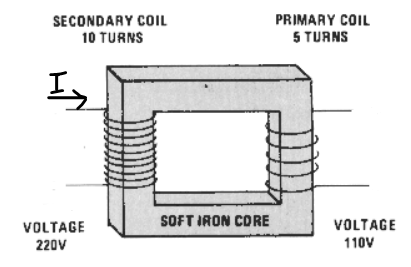 Warm-Up
:
The picture on the far right shows a transformer. The picture on
the near right shows a simplified transformer. The two coils of
insulated wire are
not connected to one another. There is a wire connecting one of
these to your home.
Warm-Up
:
The picture on the far right shows a transformer. The picture on
the near right shows a simplified transformer. The two coils of
insulated wire are
not connected to one another. There is a wire connecting one of
these to your home.
1. What does a transformer do?
2. Transformers work with alternating current (A.C.). If the left coil's current (shown in the diagram) is increasing at this moment, what is the direction of the current in the coil on the right?
3. The purpose of these transformers is to "step down" the high voltage in the transmission lines to a lower voltage that enters your home. Why do the transmission lines need to have such high voltage?
4. A table saw uses 3,000W, and it can be wired for 120V or 240V. What are the pros/cons of each voltage?
Today
:- Check/review homework -- Right Hand Rule and Lenz's Law practice Answers
- Note about Friday -- Mr. Stapleton will be gone.
- Quiz
- Work time
- Finish motor. If you already have credit, disassemble your motor.
- Instrument project
- Get Right Hand Rules and Lenz's Law, practice #2 Answers
- Back to waves and sound:
- Prior notes -- Notes: Wave and Music theory relating to fret calculations -- and fret practice -- shorten to focus only on fundamental Filled-in notes
- New notes -- Sound and Waves Notes, Part 2 Filled-in version
- String standing waves demo. How how harmonics can be found by varying either string length or vibrational frequency.
- Complete resonance lab at the end of the waves notes
Links:
Online Textbook Reading: 16.9 -- Waves
Homework:
-
Quiz on Friday over magnetism notes, right hand rules, and Lenz's Law.
-
Sign up for flex to fix instruments. RB PS, JG, LC LM, PI JG MB, JB, PG PW JD, HW, YN JB, EW JW TE,
 Class
72.5 Friday,
4/19/19
Class
72.5 Friday,
4/19/19Warm-Up : The permanent magnet of the pickup on the right magnetizes the nearby section of steel string. This string is currently moving upward as it vibrates near the pickup.
1. What is the direction of the string's magnetic field?
2. Is the flux from that field increasing or decreasing through the pickup coil?
3. Through which wire is current flowing toward the amplifier.
4. Assuming that current travels straight through the amplifier on its way to the speaker, is the speaker cone currently being pulled toward the speaker magnet, or is it being pushed away from the speaker magnet?
Today
:-
make a simple motor, like this one
 .
You will be provided with a magnet like the one in the picture, a D.C.
power source, alligator clips, paper clips, wood or cardboard, and 1-2
meters of 24 gauge
enameled magnet wire. To be complete, your motor must run for at
least 20 seconds on its own. You may give it a push to get it
started.
.
You will be provided with a magnet like the one in the picture, a D.C.
power source, alligator clips, paper clips, wood or cardboard, and 1-2
meters of 24 gauge
enameled magnet wire. To be complete, your motor must run for at
least 20 seconds on its own. You may give it a push to get it
started. - Make a speaker using 2m
of 28gauge enameled wire, a few disk magnets, an audio jack with
alligator clips, paper.
 You will also need glue and/or tape. Here's what mine looked
like before I snipped off too much of the air pushing surface
("cone")
You will also need glue and/or tape. Here's what mine looked
like before I snipped off too much of the air pushing surface
("cone")
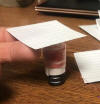 . Here are the directions.
. Here are the directions.

Homework: Complete the rest of Right Hand Rule and Lenz's Law practice
 Class
72 Thursday, 4/18/19
Class
72 Thursday, 4/18/19Warm-Up : Lenz's Law says that an induced current acts to keep magnetic flux constant. The hyperlinked diagram on the right illustrates applications of this law. According to Lenz's Law, when the coil is rotated as shown in the generator below, through which wire will current enter the bulb?

Today
:- In-class practice with RHRs and Lenz's Law.
- After you finish your buzzer, disassemble it and put the wire back on a piece of cardboard.
-
make a simple motor, like this one
 .
You will be provided with a magnet like the one in the picture, a D.C.
power source, alligator clips, paper clips, wood or cardboard, and 1-2
meters of 24 gauge
enameled magnet wire. To be complete, your motor must run for at
least 20 seconds on its own. You may give it a push to get it
started.
.
You will be provided with a magnet like the one in the picture, a D.C.
power source, alligator clips, paper clips, wood or cardboard, and 1-2
meters of 24 gauge
enameled magnet wire. To be complete, your motor must run for at
least 20 seconds on its own. You may give it a push to get it
started. - Make a speaker using 2m
of 28gauge enameled wire, a few disk magnets, an audio jack with
alligator clips, paper.
 You will also need glue and/or tape. Here's what mine looked
like before I snipped off too much of the air pushing surface
("cone")
You will also need glue and/or tape. Here's what mine looked
like before I snipped off too much of the air pushing surface
("cone")

Homework: Complete 1-19 of Right Hand Rule and Lenz's Law practice pdf version
 Class 71.5
Wednesday, 4/17/19
Class 71.5
Wednesday, 4/17/19Warm-Up :
1. Based on the direction of current flow, in which direction are the speaker cone and voice coil being pushed (or pulled) by the permanent magnet?
2. To make a simple motor, should you sand one side or both sides of each end of your magnet wire?
Today
:- Look at tests
- Finish your buzzer; build a motor.
-
make a simple motor, like this one
 .
You will be provided with a magnet like the one in the picture, a D.C.
power source, alligator clips, paper clips, wood or cardboard, and 1-2
meters of 24 gauge
enameled magnet wire. To be complete, your motor must run for at
least 20 seconds on its own. You may give it a push to get it
started.
.
You will be provided with a magnet like the one in the picture, a D.C.
power source, alligator clips, paper clips, wood or cardboard, and 1-2
meters of 24 gauge
enameled magnet wire. To be complete, your motor must run for at
least 20 seconds on its own. You may give it a push to get it
started.
Homework: None
Warm-Up : None
Today
:- Test today
- Wednesday -- finish your buzzer; build a motor.
Homework:
Tonight's homework -- Use the web to learn out
how to make a simple motor, like this one .
Make sure that you understand how it works. Here's
one video.
You will be provided with a magnet like the one in the picture, a D.C.
power source, alligator clips, paper clips, wood or cardboard, and
enameled magnet wire.
.
Make sure that you understand how it works. Here's
one video.
You will be provided with a magnet like the one in the picture, a D.C.
power source, alligator clips, paper clips, wood or cardboard, and
enameled magnet wire.
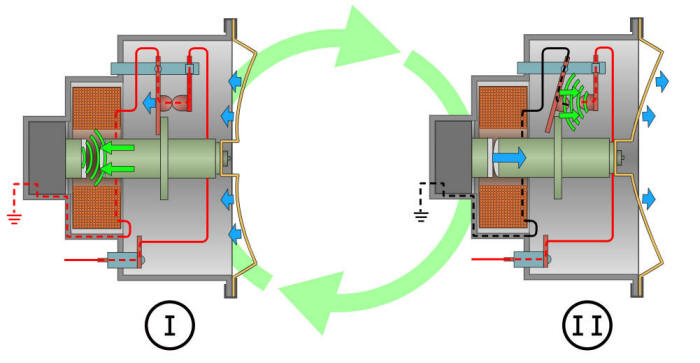 Class 70.5
Monday, 4/15/19
Class 70.5
Monday, 4/15/19Warm-Up :
A standard car horn is essentially a solenoid buzzer.
1. Which color (red or black) represents a complete circuit?
2. Where is the solenoid?
3. What makes this
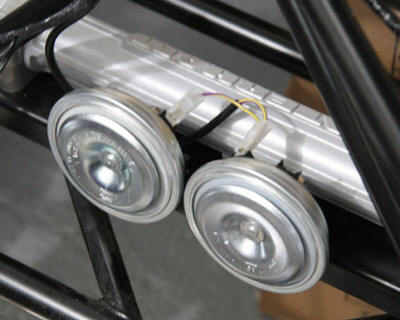 louder than the buzzer you have been working
on?
louder than the buzzer you have been working
on?
4. Why does the bottom diagram show two horns? Horn intervals
Today
:- Questions about tomorrow's test?
- Magnetism Notes
- Wednesday -- finish your buzzer; build a motor.
Homework:
Due on Wednesday -- Use the web to learn out
how to make a simple motor, like this one .
Make sure that you understand how it works. Here's
one video.
You will be provided with a magnet like the one in the picture, a D.C.
power source, alligator clips, paper clips, wood or cardboard, and
enameled magnet wire.
.
Make sure that you understand how it works. Here's
one video.
You will be provided with a magnet like the one in the picture, a D.C.
power source, alligator clips, paper clips, wood or cardboard, and
enameled magnet wire.
 Class 70
Friday, 4/12/19
Class 70
Friday, 4/12/19
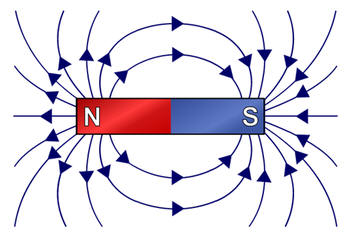 Warm-Up:
Warm-Up:
The left and right top diagrams on the right show magnetic field lines and the a right hand rule, respectively. If you grab a current-carrying wire and point your right thumb in the direction of current, as shown, your fingers will point in the direction of the magnetic field.

1. The third diagram shows a solenoid. What is the difference between the words solenoid and electromagnet?
2. In the third diagram, which end of the magnetized iron nail is north -- once the switch is closed?
3. Why is the north pole of a magnet called the "north" pole?
4. How does a solenoid work in an electrical relay?
Today
:- Check for buzzer sketches
- Magnetism Notes
- Make a solenoid buzzer.
- Wood, nails, hot glue/glue guns, duct tape, enameled wire, sandpaper, saw, strips of magnetizable steel (approx 0.5" wide, 3" long), and a D.C. power source.
- With those materials, you will have to make a working solenoid buzzer -- in groups of 2. You may cut, glue, or tape things, but you will not be allowed to nail or drill. Nailing and drilling are not necessary.
Homework: None
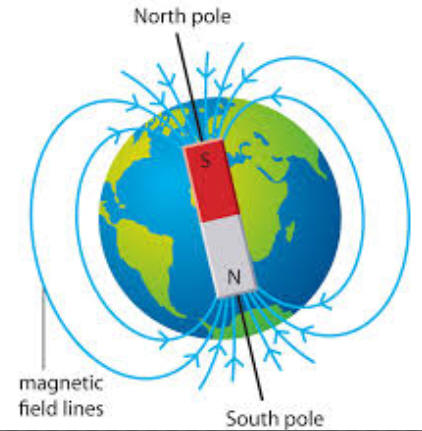 Class
69.5 Thursday, 4/11/19
Class
69.5 Thursday, 4/11/19Warm-Up :
1. What's wrong with this diagram?
2. Why is the north pole of a magnet called the "north" pole?
Today
:- 7/8 Check/review homework -- problems in Practice Test: Chapter 20-21. Solutions
- Mr. P's 4 minute drill Solutions
- Draw buzzer designs
- Mr. Pennington's test review sheet (doesn't include Kirchoff's Laws)
- Interesting Link: Electricity FAQs
- Magnetism Notes
- rhrs
Homework:
-
Watch this
instructional video showing how to make a solenoid buzzer.
Draw a sketch of a solenoid buzzer design that uses
only the materials below:
- wood, nails, hot glue/glue guns, duct tape, enameled wire, sandpaper, saw, strips of magnetizable steel (approx 0.5" wide, 3" long), and a D.C. power source.
- With those materials, you will have to make a working solenoid buzzer -- in groups of 2. You may cut, glue, or tape things, but you will not be allowed to nail or drill. Nailing and drilling are not necessary.
 Class
69 Wednesday, 4/10/19
Class
69 Wednesday, 4/10/19Warm-Up : A simple motor can be made by running current through an insulated coil of wire, which then behaves like a magnet and pushes or pulls other magnets, depending upon their polarity.
A generator does this in reverse. When a magnet is pushed or pulled in proximity to a coil of wire, current is produced in the wire.

Do you suppose the magnetic guitar pickup (lower right) is a motor or is it a generator?
Today
:- Finish reviewing multiple choice practice test questions.
- Check homework -- Complete the second problem in Kirchoff's Rules Practice #2 (last problem of the packet). The preceeding problem is optional. Solutions
- Discuss circuit lab questions.
- Mr. P's 4 minute drill Solutions
- Complete the problems in Practice Test: Chapter 20-21. Solutions
- Mr. Pennington's test review sheet (doesn't include Kirchoff's Laws)
- Interesting Link: Electricity FAQs
- rhrs
Homework:
-
Watch this
instructional video showing how to make a solenoid buzzer.
Draw a sketch of a solenoid buzzer design that uses
only the materials below:
- wood, nails, hot glue/glue guns, duct tape, enameled wire, sandpaper, saw, strips of magnetizable steel (approx 0.5" wide, 3" long), and a D.C. power source.
- With those materials, you will have to make a working solenoid buzzer -- in groups of 2. You may cut, glue, or tape things, but you will not be allowed to nail or drill. Nailing and drilling are not necessary.
- Test next Tuesday over chapters 20-21.
- A7/8 -- complete problems in Practice Test: Chapter 20-21. Solutions
 Class
68.5 Tuesday, 4/9/19
Class
68.5 Tuesday, 4/9/19Warm-Up :
Use Kirchoff's loop rule to write an equation for the largest of the three loops in the diagram on the right.
Today
:-
Check/review homework:
- Complete the rest of the problems in Kirchoff's Rules 21.3 Notes and practice Solutions
- Complete the multiple choice in Practice Test: Chapter 20-21. Solutions
- Hand back and discuss circuit lab questions.
- The test will be this Friday. There's plenty of time to prepare. :-)
Homework:
 Class
68 Monday, 4/8/19
Class
68 Monday, 4/8/19Warm-Up : When electric current flows through an electric motor, a force is produced, causing motion. An electric motor forced into motion generates electric current.
I have three identical corded drills and one driver bit. With no additional materials, how can we power two of the drills by plugging just one of them into the wall?
Today
:- Collect circuit lab questions. Hand back and discuss circuit lab questions.
- Kirchoff's Rules 21.3 Notes and practice Solutions
- Practice Test: Chapter 20-21. Solutions
Online Textbook Reading: Chapter 20 -- Electric Current
Homework:
- Complete the rest of the problems in Kirchoff's Rules 21.3 Notes and practice Solutions
- Complete the multiple choice in Practice Test: Chapter 20-21. Solutions
 Class
67.5 Friday, 4/5/19
Class
67.5 Friday, 4/5/19Warm-Up :
Imagine a 110V home circuit that powers two light bulbs, a 100W bulb and a 60W bulb.
1. Is the circuit most likely a parallel circuit or a series circuit? How do you know?
2. Which bulb will burn brighter when they are both turned on?
3. Through which bulb will more current flow?
4. Which bulb has a higher resistance?
5. Why do the bulbs use more power than the wires that carry current to the bulbs?
Today
:- Finish lab. Turn in one per group, with all of your names on it. Labs will be graded loosely on correctness. You will lose points for impossible answers, but not for slightly inaccurate measurements.
-

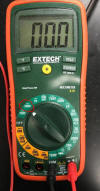
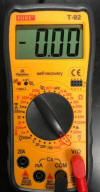
Online Textbook Reading: Chapter 20 -- Electric Current
Homework: None
 Class
67 Thursday, 4/4/19
Class
67 Thursday, 4/4/19Warm-Up : Assuming that the wires on the right have zero resistance...
1. What is the equivalent resistance of the entire circuit?
2. How much current flows through the resistor on the far right?
3. The graph below shows current flowing through a light bulb at a variety of voltages. What does the slope of this graph represent? Do these light bulbs obey Ohm's Law?
 Today
Today
- Check/review homework: "Circuit Reduction -- The Nine Companions" Solutions
- Notes and Circuit lab (using multimeters and DC power supplies) -- keep voltages per bulb under 6V. Filled-In Notes
- Labs will be graded loosely on correctness. You will lose points for impossible answers, but not for slightly inaccurate measurements.
-



Online Textbook Reading: Chapter 20 -- Electric Current
Homework: None
Warm-Up :
1. How can we estimate the average speed (in m/s) at which data travel to this computer over the internet?
2. Is this an electrical signal?
Today
:-
Check/review homework:
- A 5/6 -- Problem 1 from Ch21 Equivalent Resistance Challenge Solutions
- A 7/8 -- Problem 2 from Ch21 Equivalent Resistance Challenge Solutions
- Get "Circuit Reduction -- The Nine Companions" Solutions
Online Textbook Reading: Chapter 20 -- Electric Current
Homework: Finish "Circuit Reduction -- The Nine Companions" Solutions
 Class
66 Tuesday, 4/2/19
Class
66 Tuesday, 4/2/19Warm-Up : Check out the active graphic DC Circuit Water Analogy at Hyperphysics.com. According to the analogy...
1. Voltage is like _____
2. Resistance is like _____
3. Current is like _____
Today
:- Check/review homework: 20.2 -- Notes and Practice Practice Solutions
- Notes: 20.3, 20.4, 21.1 Filled-in notes
- Problem 1 from Ch21 Equivalent Resistance Challenge Solutions
- Tomorrow -- "Circuit Reduction -- The Nine Companions" Solutions
- Thursday -- Circuit-Building Lab
Online Textbook Reading: Chapter 20 -- Electric Current
Homework: Problem 2 from Ch21 Equivalent Resistance Challenge Solutions
 Class
65.5 Monday, 4/1/19
Class
65.5 Monday, 4/1/19Warm-Up : The deceptively complicated case of the electrified pickle...
Why does the pickle light up? Why does it light up on just one end? Is it always the same end?
Hyperphysics electric pickle info
Today
:- Check/review homework: Chapter 19.1 and 19.2, Notes and Practice 19.1 and 19.2 Solutions and Filled-in Notes
- New: 20.2 -- Notes and Practice Practice Solutions
Online Textbook Reading: Chapter 20 -- Electric Current
Homework: Complete practice in 20.2 -- Notes and Practice Practice Solutions
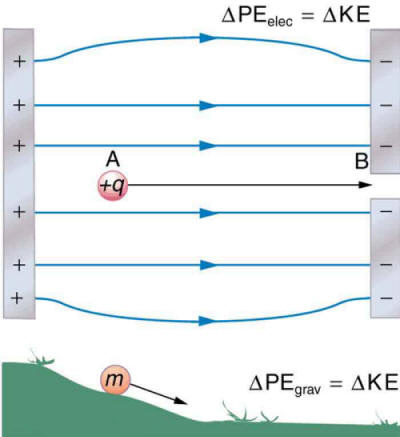 Class
65 Friday, 3/29/19
Class
65 Friday, 3/29/19Warm-Up : The diagram on the right shows two examples of acceleration and energy conservation.
1. What are the units for PEelec?
2. Where could you move the positive charge in order to increase its electrical potential energy?
3. Electrical Potential (a.k.a. voltage) is the ratio electrical potential energy to charge. What are the units of electrical potential?
4. This analogy comparing PEelec to PEgrav isn't perfect. Can you identify a shortcoming?
Today
:- I told someone I would add a point, and I forgot. Whose was it?
- Take a look at the online textbook: 19.1 20.1
- Rest of the year (rough plan):
- Current and Circuits
- Spring Break
- Waves and Sound
- Optics
- Chapter 19.1 and 19.2, Notes and Practice 19.1 and 19.2 Solutions and Filled-in Notes
Online Textbook Reading: Chapter 19.1 -- Electrical Potential (Voltage) Chapter 20 -- Electric Current
Homework: Complete practice in Chapter 19.1 and 19.2, Notes and Practice 19.1 and 19.2 Solutions and Filled-in Notes
 Class
64.5 Thursday, 3/28/19
Class
64.5 Thursday, 3/28/19Warm-Up :
1. What can Tango and Cash teach us about electricity?
2. If you had to choose between touching a suspicous wire with the back of your hand or your palm, which should you choose? Why?
Today
:-
Return Tizzes
-
New Unit: Current and Circuits
- Silly video -- "Brainacs" getting shocked by an electric fence.
- Can we simulate an electric
fence
 with an electric dog collar
with an electric dog collar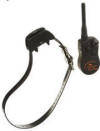 ?
?- Take a look at the online textbook: 19.1 20.1
- Rest of the year (rough plan):
- Current and Circuits
- Spring Break
- Waves and Sound
- Optics
Online Textbook Reading: Chapter 19.1 -- Electrical Potential (Voltage) Chapter 20 -- Electric Current
Homework: None
Warm-Up :
None
Today
:-
Tiz
Homework: None
 Class
63.5 Tuesday, 3/26/19
Class
63.5 Tuesday, 3/26/19Warm-Up :
1. Why doesn't a bird on an uninsulated power line get shocked?
2. Would a bird get shocked if it landed on a Van de Graaff generator?
3. How can we test #2?
4. Why shouldn't you try #1?
Today
:-
Turn-in test corrections for rotational motion test.
-
Check/discuss 18.7-18.8 practice 18.7 Mr. P. Solutions 18.8 Mr. P. solutions Mr. S. Solutions
-
Tomorrow's Quiz/test format -- subject to minor change: 15 multiple choice, 1 short answer, 6 problems (4 problems with electrostatics equations, 2 electrostatics applications problems involving kinematics and/or F=ma and/or w=mg.)
-
Note card
Online Textbook Reading: Chapter 18.7
Homework: Study

 Class
63 Monday, 3/25/19
Class
63 Monday, 3/25/19Warm-Up :
1. What is a spark?
2. How does a plasma ball work? Breakdown voltages, relative to air. tesla coil
3. How does a jacob's ladder work?
Today
:-
Check/discuss Electrostatics Practice Test (Mr Pennington's Old Test) -- Answer Key
-
Quiz format -- subject to minor change: 15 multiple choice, 1 short answer, 6 problems.
-
Work time:
-
Static Equilbrium and Applications Problems: Work on 18.7-18.8 practice 18.7 Solutions 18.8 solutions
-
Note card
-
Online Textbook Reading: Chapter 18.4 and 18.5
Homework: Finish 18.7-18.8 practice 18.7 Solutions 18.8 solutions Video solutions: 18.7, number 2 18.7-18.8 -- the rest
 Class
62.5 Thursday, 3/21/19
Class
62.5 Thursday, 3/21/19Warm-Up :
Suppose the neutral conductor in diagram A is placed in the electric field shown in diagram B.
1. How will the charges that are currently shown on the conductor rearrange themselves? Assume that both positive and negative charges can move equally well.
2. How will the electric field lines rearrange themselves?
3. Diagram C shows two conductors with excess positive charges.
Why do the excess charges reside on the conductors' surfaces? Why are the charges closer together near the pointy part of the
rightmost conductor? What implications does this have for Van de
Graaff generator design?
Why are the charges closer together near the pointy part of the
rightmost conductor? What implications does this have for Van de
Graaff generator design?
Today
:-
Check/discuss
-
Electric Field Hockey
-
-
Notes: 18.7 -- Conductors and Fields in Static Equilibrium. Notes 18.7 Key
Online Textbook Reading: Chapter 18.7 and 18.8
Homework: Electrostatics Practice Test (Mr Pennington's Old Test) -- Answer Key
 Class
62 Wednesday, 3/20/19
Class
62 Wednesday, 3/20/19Warm-Up :
How does a Van de Graaff Generator Work?
MIT video -- inducing dipoles with a VDG
Today
:-
Check/discuss 18.3 Notes and Practice Solutions
-
Good explanation of how the classroom Van de Graaff Generator works -- but backward relative to our classroom VDG.
-
Notes 18.4 (Electric Field) -18.5 (Electric Field Lines). Filled in Notes: 18.4 18.5
-
Complete Electric Field Hockey simulation in Notes 18.4 (Electric Field) -18.5 (Electric Field Lines)
Online Textbook Reading: Chapter 18.4 and 18.5
Homework:

 Class
61.5 Tuesday, 3/19/19
Class
61.5 Tuesday, 3/19/19Warm-Up :
The electrophorus is charged by rubbing a cat(fur) against the top of an insulating plate (I). Then the conducting plate (C) is placed on top of the insulating plate and is touched by the physicist. Assuming that the cat fur has a strong affinity for negative charge...
1. What is the charge of the plate after it is touched by the scientist?
2. Explain how the conducting plate becomes charged.
3. What is the ground in this demonstration?
Today
:-
Check/discuss
Ch 18.3: Coulomb's Law 18.3 Notes and Practice Filled-in Notes
Online Textbook Reading: Chapter 18.3
Homework: Complete 1-5 in 18.3 Notes and Practice Solutions
 Class
61 Monday, 3/18/19
Class
61 Monday, 3/18/19Warm-Up :
1. If you rub a balloon on your head and then hold it next to your hair, your hair is attracted to the balloon. Why?
2. Your hair may also stand on end after being rubbed by a balloon. Why?
3. The balloon may stick to the wall or ceiling. Why?
4. This all works better in drier air. Why?
5. What events contributed to this gas station fire?
Today
:-
There will be no more instrument work time in class. We will return to the instruments after the electricity units.
-
Rotational motion quiz corrections due next Tuesday.
-
Notes and Practice -- 18.1 and 18.2 (Static Electricity & Charge, Conductors and Insulators) Filled-in Notes
-
Phet Simulations -- Complete questions: Balloons and John Travoltage
- Today -- Ch. 18.1 and 18.2: Static Electricity and Charge; Conductors and Insulators
- Tuesday -- Ch 18.3: Coulomb's Law 18.3 Notes 18.3 Practice
- Wednesday -- Ch 18.4 and 18.5: Electric Fields and Field Lines
- Thursday -- 18.7: Conductors and Fields in Static Equilibrium
- Friday -- Conferences
- Monday -- Electrostatics Practice Test (Mr Pennington's Old Test) -- Answer Key
- Tuesday -- "4 minute drill", Quiz review
- Wednesday -- Quiz
- Thursday -- Return Quizzes -- Corrections due by Tuesday
- Friday -- Last day of the quarter -- Begin Chapters 20-21 -- Current and Circuits
Online Textbook Reading: Chapter 18.1 and 18.2
Homework:
 Class
60.5 Friday, 3/15/19
Class
60.5 Friday, 3/15/19Warm-Up :
See example slide, on the right.
Today:
- Clean up:
- Scrape and brush countertops
- Clean out cabinets and store instruments in an organized manner.
- Finishing touches -- stringing, tuning
- Get a nice photo of your instrument and fill out a slide for your group.
- Sources for songs to play (easiest major keys are C and G; easy
minor keys are Am and Em):
- ukulele -- ukutabs.com
- tuning in 5ths -- mandotabs.com
Online Textbook Reading:
Homework:
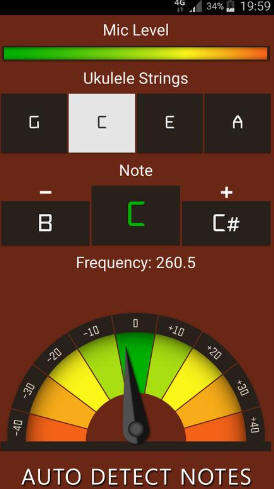
 Class
60 Thursday, 3/14/19
Class
60 Thursday, 3/14/19Warm-Up :
1. What are some ways of tuning a string instrument?
3. How do you know what key a song is in, based on chords? How can you change the key?
Today: Last full work day. Tomorrow we clean up and store the instruments in a careful, intentional manner. Any additional work will need to be done during flex.
- I have new, laser cut bridges and nuts that should work for most instruments. If the nut is too low, you may be able to raise it with a shim.
-
Relative tuning method -- you won't know what key you're in, but if
your instrument is well made, this should get it to sound in tune

- Final Instructions
- Sources for songs to play (easiest major keys are C and G; easy
minor keys are Am and Em):
- ukulele -- ukutabs.com
- tuning in 5ths -- mandotabs.com
Online Textbook Reading:
Homework:
 Class
59.5 Wednesday, 3/13/19
Class
59.5 Wednesday, 3/13/19Warm-Up :
How do this bridge and nut need to be modified?
Today:
- There are more green tuners today.
Online Textbook Reading:
Homework:
Warm-Up :
Watch videos -- saddles, knobs, plastic tuners (easy green ones, black ones)
Today:
- Final steps, attaching the saddle, adding the string, tuning.
Online Textbook Reading:
Homework:

 Class
58.5 Monday, 3/11/19
Class
58.5 Monday, 3/11/19Warm-Up :
Today:
- Final steps -- wrapping the fret wire, attaching the saddle, adding the string, tuning.
Online Textbook Reading:
Homework:

 Class
58
Thursday, 3/9/19
Class
58
Thursday, 3/9/19Warm-Up :
These pictures compare the fret "wire" that we will be using to standard fret wire. We will wrap the fret wire.
Why does the fret wire need to be wrapped very tightly?
Today:
- Final steps -- wrapping the fret wire. Attaching the saddle.
Online Textbook Reading:
Homework:
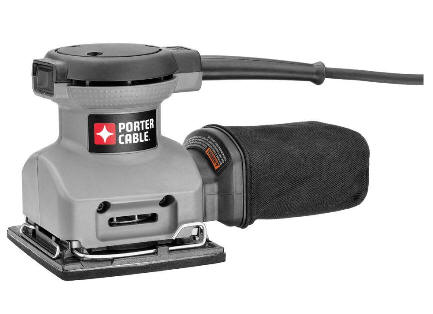 Class
57.5
Thursday, 3/7/19
Class
57.5
Thursday, 3/7/19Warm-Up :
1. How do you load new sandpaper into this type of finishing sander?
2. What's the number 1 rule for prolonging the life of sandpaper in the finishing sander?
Today:
- Video -- how to swap sandpaper in the finishing sander
- Prepare a neck and fret board. Label and store them with your names and a piece of tape.
Online Textbook Reading:
Homework:
 Class
57
Wednesday, 3/6/19
Class
57
Wednesday, 3/6/19Warm-Up :
What hazards are posed by a belt sander?
Today:
- Google search for Mrstapleton.com is acting funny.
- A5/6 ends at 12:49. A7/8 starts at 1:23.
- Belt sander: Use it for body edges, corners, and your peg box (video).
- New dust collector switch
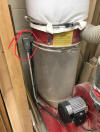
- Video: Cleaning the belt sander
- Video: Laser Cutting the body
- Pre-made hole patterns:

- Prepare a neck and fret board. Label and store them with your names and a piece of tape.
Online Textbook Reading:
Homework:
 Class
56.5
Tuesday, 3/5/19
Class
56.5
Tuesday, 3/5/19Warm-Up :
What are the most important things to remember when you're using a scroll saw?
Today:
- Prepare a neck and fret board. Label and store them with your names and a piece of tape.
- Finish
Notes: Wave and Music theory relating to fret calculations -- and
fret practice -- shorten to focus only on fundamental
Filled-in notes
- Division of the octave
- Calculating vibrating string length (distance from nut to frets).
- Mechanical Waves Links
Online Textbook Reading:
Homework: Email this to Mr. Stapleton... Modify this fret calculation template to create a spreadsheet that will calculate fret positions for any length string. You will use this spreadsheet for calculating your instrument's fret positions. Answers for a 33cm bridge-to-nut distance @440Hz. Video showing how to do this.
 Class
56
Monday, 3/4/19
Class
56
Monday, 3/4/19Warm-Up : The frequency of a wave describes number crests or troughs that pass a particular point in a given amount of time (a.k.a. cycles per second). The units are Hertz (Hz).
1. What is the frequency of the wave pattern on the right?
2. If the distance between two successive crests (i.e. wavelength) is 4m, what is the speed of the waves on the right?
3. What is the formula for wave speed, in terms of frequency and wavelength?
Today:
- Assemble/glue instrument bodies and peg boxes.
- If you want help with your sound hole design, come to my flex tomorrow.
-
Notes: Wave and Music theory relating to fret calculations -- and
fret practice -- shorten to focus only on fundamental
Filled-in notes
- Wave interference and standing waves
- Standing wave simulation
- Make interfering and standing waves, using a shlinky
- Standing wave video
- Division of the octave
- Calculating vibrating string length (distance from nut to frets).
- Mechanical Waves Links
Online Textbook Reading:
Homework: None
 Class
55.5
Friday, 2/22/19
Class
55.5
Friday, 2/22/19Warm-Up : Suppose you need to want to build a camp fire. You have plenty of dry wood, but it's all big limbs that are too long to be manageable and too thick to break over your knee. Without using a saw or an axe, what's the best way to divide the wood into smaller pieces? Can you describe the proper technique? One solution.
Today:
- Return tests
- Assemble instrument bodies. Glue, tape, and label with your names.
Online Textbook Reading:
Homework: None
Warm-Up : No warm-up
Today:
- Test
- Tomorrow -- return tests and assemble instrument bodies.
Online Textbook Reading:
Homework: None
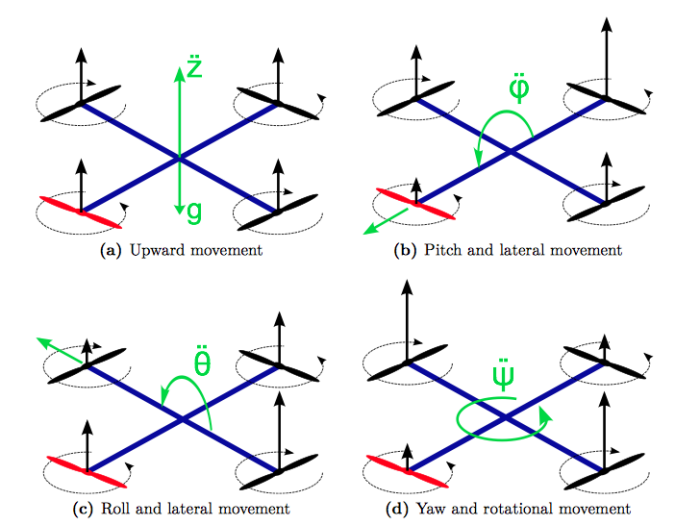 Class
54.5 Wednesday,
2/20/19
Class
54.5 Wednesday,
2/20/19Warm-Up : A quadcopter has four propellers that usually alternate in their directions of rotation.
- How does conservation of angular momentum enable this quadcopter achieve a yaw?
- In order to pitch or roll, why can't one motor just speed up (without the opposite motor slowing down)?
Today:
- Try the device?
- Problems from Rotational Motion Test Review #1 Solutions to Pennington Test Review
-
Test Practice Materials:
-
Rotational Motion Practice Test # 2, Rotational Motion
- Solutions to Rotational Motion Practice Test #2.
- If you don't understand the solutions,
watch the videos below.
Online Textbook Reading: Chapter 10
Homework: Test tomorrow
 Class
54 Tuesday,
2/19/19
Class
54 Tuesday,
2/19/19Warm-Up :
- How do falling cats always manage to land on their feet?
- Why do falling people flail their arms around?
Today:
- About half of you filled out the form. I doubled the materials that it looked like I was going to need, based on the form. If you submitted the form by 8:00 this morning, you're guaranteed to get what you asked for.
- If you want to have a scale length (nut to bridge) that is longer than about 15 inches, please let me know your scale length by email.
- Check/review homework: Multiple choice from Rotational Motion Test Review #1 Solutions to Pennington Test Review
-
Test Practice Materials:
-
Rotational Motion Test Review #1 Solutions to Pennington Test Review Problem solution video Multiple Choice Solution Video
-
Rotational Motion Practice Test # 2, Rotational Motion
Solutions
to Rotational Motion Practice Test #2. If you don't understand the solutions,
watch the videos below.
-
Online Textbook Reading: Chapter 10
Homework:
-
Problems from Rotational Motion Test Review #1 Solutions to Pennington Test Review
-
If you want extra practice, work on Rotational Motion Practice Test # 2, Rotational Motion Solutions to Rotational Motion Practice Test #2.
 Class
53.5 Monday,
2/18/19
Class
53.5 Monday,
2/18/19Warm-Up : In the picture on the right, the wheel is spinning, and the guy is sitting motionless on a chair that rotates freely. What will happen when he flips the wheel over so that it rotates in the opposite direction?
Today:
- Fill out this form (one per group), relating to who is in your group and what type of instrument you hope to make.
-
Check/review homework:
-
# 1,2,4 and 5 from Chapter 10.4 -- Rotational Kinetic Energy Notes and Practice Practice Key
-
#2 and 4 from 10.5 Angular Momentum Notes and Practice Practice Key
-
-
Rotational Motion Test Review #1 Solutions to Pennington Test Review Problem solution video Multiple Choice Solution Video
-
Rotational Motion Practice Test # 2, Rotational Motion
Solutions
to Rotational Motion Practice Test #2. If you don't understand the solutions,
watch the videos below.
Online Textbook Reading:
Homework:
Multiple choice from Rotational Motion Test Review #1 Solutions to Pennington Test Review
 Class
53 Friday,
2/15/19
Class
53 Friday,
2/15/19Warm-Up : Explain how this jar lid closure works, in terms of Net Torque -- especially Tnet=Frsinθ.
You might also consider F=kx.
Today:
- How many groups want to make a 6-string instrument? -- more work. Tuning will be more difficult.
-
Example top. Hole took about 10 seconds. Engraving took
21 minutes.
 Don't
make this mistake
Don't
make this mistake
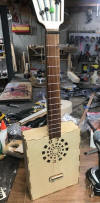
- If you want help with your instrument top, come to my flex.
- Chapter 10.4 -- Rotational Kinetic Energy Notes and Practice -- Notes Key -- Practice Key
- 10.5 Angular Momentum Notes and Practice -- Notes Key -- Practice Key -- Solution to #1
- Test next Thursday over rotational motion
Online Textbook Reading:
Homework:
-
Complete the rotational kinetic energy and angular momentum practice problems
-
# 1,2,4 and 5 from Chapter 10.4 -- Rotational Kinetic Energy Notes and Practice -- Notes Key -- Practice Key
-
#2 and 4 from 10.5 Angular Momentum Notes and Practice -- Notes Key -- Practice Key
-
Warm-Up :
No warm-up todayToday:
- Return quizzes. Corrections are due before break.
- Design sound holes. Click this link for instructions and tips.
- Example instrument file
Online Textbook Reading:
Homework:
-
None. Get a good sleep, so you're ready for rotational KE and rotational momentum tomorrow.

Warm-Up : A sphere, a cylinder, a ring, and a frictionless box are released from rest at the top of ramp. Their masses and heights are identical.
1. Rank the objects according to their arrival times at the bottom of the ramp.
2. Suppose the bottom end of the ramp is frictionless, and when they reach the bottom, the objects hit a vertical, frictionless wall. What motions, if any, would continue after impact?
3. How this event be different if the objects varied in mass and/or height?
4. The round objects are affected by friction. Would the result be different in a totally frictionless situation? Explain.
Today:
- Return quizzes. Corrections are due before break.
- Check/review homework: Chapt 10.2 and 10.3 -- Kinematics and Dynamics of Rotation Practice -- Key
- Chapter 10.4 -- Notes and Practice -- Rotational Kinetic Energy Practice --Notes Key -- Practice Key
Online Textbook Reading:
Homework:
-
Sketch a sound hole design (due on Wednesday).

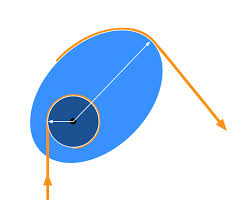 Class
51 Monday,
2/11/19
Class
51 Monday,
2/11/19Warm-Up :
1. Where does a compound bow store most of its energy?
2. What purpose(s) do the pulleys of a compound bow serve?
Today:
- Survey Responses
- Quiz finishers?
-
New concepts:
- Chapt 10.2 -- Kinematics of Rotation Notes -- Key
- Chapt 10.3 Rotational Dnamics Notes Key
- Chapt 10.2 and 10.3 -- Kinematics and Dynamics of Rotation Practice -- Key
- Design an instrument sound hole -- or sound holes. You can
cut through or engrave. Engraving (burning images) takes a lot
of time.
 If you're planning to electrify your instrument (extra work,
probably some out of class), you should account for the position of
your pickup.
If you're planning to electrify your instrument (extra work,
probably some out of class), you should account for the position of
your pickup. - On Wednesday, you will be creating CAD files of your
design.
Online Textbook Reading:
Homework:
-
Chapt 10.2 and 10.3 -- Kinematics and Dynamics of Rotation Practice -- Key
-
Sketch a sound hole design (due on Wednesday).
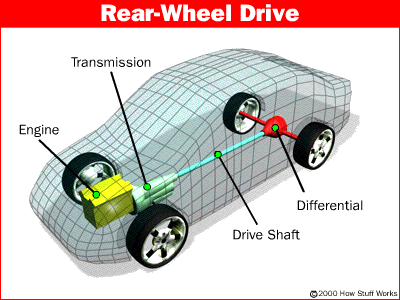
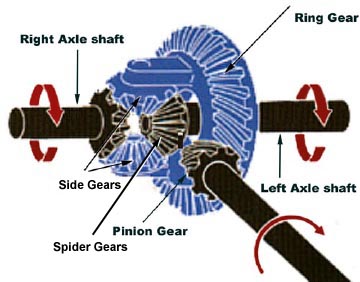 Class
50.5 Friday,
2/7/19
Class
50.5 Friday,
2/7/19Warm-Up :
1. What does a differential do?
2. How does a differential work?
Today:
-
Return Quiz and other papers
-
Check/review Angular Acceleration Practice -- Key
-
New concepts:
- Chapt 10.2 -- Kinematics of Rotation Notes -- Key
- Chapt 10.2 -- Kinematics of Rotation Practice -- Key
Online Textbook Reading: Chapter 8: Linear Momentum and Collisions
Homework:
-
None
 Class
50 Thursday,
2/7/19
Class
50 Thursday,
2/7/19Warm-Up : What do you notice about this comic situation portrayed in the Stall Street Journal?
Today:
-
Quiz
-
A5/6 -- Finish Acceleration Notes
Online Textbook Reading: Chapter 8: Linear Momentum and Collisions
Homework:
 Class
49.5 Wednesday,
2/6/19
Class
49.5 Wednesday,
2/6/19Warm-Up : Suppose you need to screw an abutment into a fixture that is implanted in someone's jaw. How can you make sure that you screw it in just tight enough, but not too tight?
Today:
-
Check/review homework Torque Practice (Pennington) Torque Practice Solutions
- Angular Acceleration Notes -- Key
- Angular Acceleration Practice -- Key
Online Textbook Reading: Chapter 8: Linear Momentum and Collisions
Homework:
-
Test tomorrow over impulse and momentum.
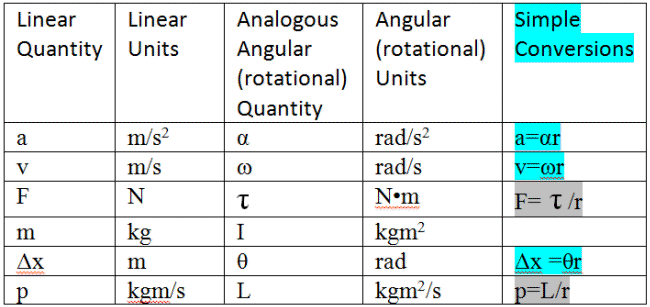 Class
49 Tuesday,
2/5/19
Class
49 Tuesday,
2/5/19Warm-Up : In the rotational (angular) motion unit, we will be using new units that are analogous to our current, linear units. You will need to be able to work in radians.
1. 360º = _____ radians
2. 90º = _____ radians
Today:
-
Linear Momentum Practice Quiz (last year's quiz, mostly) Solutions
-
Return impulse lab.
-
Torque
Online Textbook Reading: Chapter 8: Linear Momentum and Collisions
Homework: Torque Practice (Pennington) Torque Practice Solutions
Warm-Up :
Shoot a board with Nerf darts and see if our answers to Friday's warmup were correct.
Today:
-
Check/review # 8,9,10,11,13,14 in Coefficient of Restitution, Plus Various Momentum Problems Solutions (except 13-14) Solutions to 13 and 14
-
Return impulse lab.
-
Discuss Egg Bungee Assignment -- Most groups are not providing a proper answer to the question. Grading is out of 4 points; 1 point each for: visible and correct axes labels, visible axes numbers, correct calculations, correct answer to the question. You can resubmit a screen shot for full credit. The assignment is required.
Online Textbook Reading: Chapter 8: Linear Momentum and Collisions
Homework: Linear Momentum Practice Quiz (last year's quiz, mostly) Solutions
 Class
48 Friday,
2/1/19
Class
48 Friday,
2/1/19Warm-Up :
Suppose I stand a board on end and shoot it with a Nerf ® dart.
1. Am I more likely to knock the board over if I use a dart that sticks to the board or if I use a dart that bounces off of the board? Why?
2. Which experiences a greater impulse, the dart or the board? Or do they experience the same impulse?
Today:
-
Check/review Mr. Pennington's Old Momentum Test. Answers/Solutions.
-
Turn in impulse lab -- Discuss data and answers
-
Coefficient of Restitution, Plus Various Momentum Problems Do first example and number 7. Talk about #13.
-
Group bungee problem is due today. See details from last class.
Online Textbook Reading: Chapter 8: Linear Momentum and Collisions
Homework: Complete # 8,9,10,11,13,14 in Coefficient of Restitution, Plus Various Momentum Problems Solutions (except 13-14) Solutions to 13 and 14
Warm-Up :
No warm-up today. Mr. Stapleton gone.
Today:
-
Complete Mr. Pennington's Old Momentum Test. Answers/Solutions.
-
Finish the group homework (below)
-
Finish the impulse lab from yesterday.
Online Textbook Reading: Chapter 8: Linear Momentum and Collisions
Homework:
-
Individual: (handed out yesterday) Mr. Pennington's Old Momentum Test. Answers/Solutions.
-
Due tomorrow (1 per group): Using these data, calculate the final bungee distance from the floor for a 300g bungee jumper that free-falls 0.5m. Calculate an answer and create a screen shot of your graphical solution. Make sure that your screen shot clearly shows the axes labels and numbers, and that it clearly shows the two curves intersecting at your answer. Submit your work by emailing me two things -- 1) your answer 2) the screen shot
-
Due tomorrow (1 per group): Impulse Lab (from yesterday).
 Class
47 Wednesday,
1/30/19
Class
47 Wednesday,
1/30/19Warm-Up :
How can an understanding of momentum help you turn a towel into a better whip?
Today:
-
Check/review homework Notes and Ballistic Pendulums: 8.3 -- Conservation of Momentum and 8.4 -- Elastic and Inelastic Collisions, find the initial velocity of the projectile in example launch 2. Spreadsheet Solution
-
Impulse Notes and Practice -- Old Notes Key, Old Practice Key
-
Complete Lab -- Collision and Impulse and turn in -- one sheet per group of up to 3 students.
-
Get work for tomorrow -- Mr. Pennington's momentum quiz.
Online Textbook Reading: Chapter 8: Linear Momentum and Collisions
Homework:
-
Due on Friday (1 per group): Using these data, calculate the final bungee distance from the floor for a 300g bungee jumper that free-falls 0.5m. Calculate an answer and create a screen shot of your graphical solution. Make sure that your screen shot clearly shows the axes labels and numbers, and that it clearly shows the two curves intersecting at your answer. Submit your work by emailing me two things -- 1) your answer 2) the screen shot
Warm-Up :
No warm-up today. Not enough time.Today:
-
Check/review homework Notes and Practice: Linear Momentum and Force Problems Key
-
Notes and Ballistic Pendulums: 8.3 -- Conservation of Momentum and 8.4 -- Elastic and Inelastic Collisions Answer Key
Online Textbook Reading: Chapter 8: Linear Momentum and Collisions
Homework:
-
Due tomorrow: Using the data from Notes and Ballistic Pendulums: 8.3 -- Conservation of Momentum and 8.4 -- Elastic and Inelastic Collisions, find the initial velocity of the projectile in example launch 2.
-
Due on Friday (1 per group): Using these data, calculate the final bungee distance from the floor for a 300g bungee jumper that free-falls 0.5m. Calculate an answer and create a screen shot of your graphical solution. Make sure that your screen shot clearly shows the axes labels and numbers, and that it clearly shows the two curves intersecting at your answer. Submit your work by emailing me two things -- 1) your answer 2) the screen shot
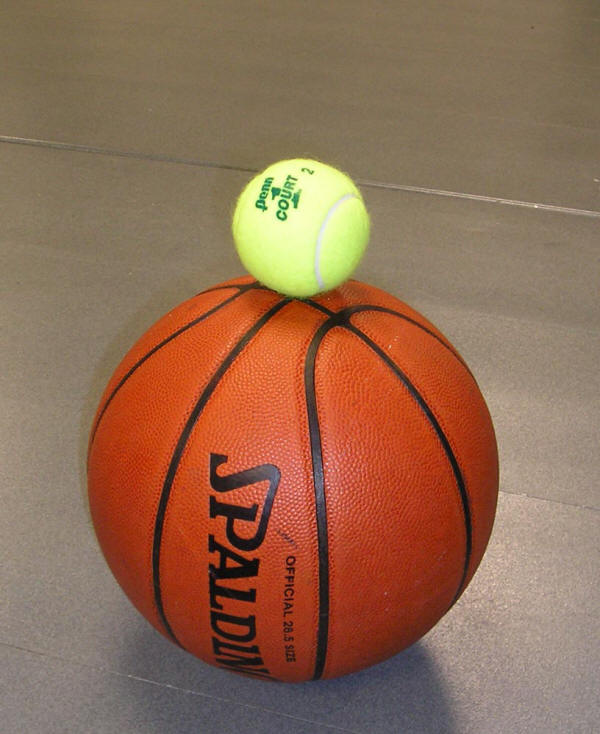 Class
46 Monday,
1/28/19
Class
46 Monday,
1/28/19Warm-Up :
1. What will happen if I hold a tennis ball on top of a basketball and drop them to the floor together?
2. What if I reverse their positions?
3. Why does this happen?
Today:
-
Return bungee homework (due last class) -- discuss answer and solution.
-
Get data to test your group's bungee drop calculating abilities. See homework assignment, below.
-
Notes and Practice: Linear Momentum and Force Notes Key Problems Key
-
Collect data relating to ballistic pendulum swing height and projectile mass. Ceate a projectile with a mass between 10g and 20g that will travel as fast as possible when shot from a 1/2" potato launcher.
-
Record your swing height and projectile mass.
-
Notes and Ballistic Pendulums: 8.3 -- Conservation of Momentum and 8.4 -- Elastic and Inelastic Collisions Answer Key
-
-
Clean up, work on homework for tomorrow or Wednesday.
Online Textbook Reading: Chapter 8: Linear Momentum and Collisions
Homework:
-
Due tomorrow: Notes and Practice: Linear Momentum and Force Notes Key Problems Key
-
Due on Wednesday (1 per group): Using these data, calculate the final bungee distance from the floor for a 300g bungee jumper that free-falls 0.5m. Calculate an answer and create a screen shot of your graphical solution. Make sure that your screen shot clearly shows the axes labels and numbers, and that it clearly shows the two curves intersecting at your answer. Submit your work by emailing me two things -- 1) your answer 2) the screen shot
Warm-Up : When you're ready to drop your egg, tell me your board heights, and I will position the board for you.
Today:
-
Turn in your homework to the wire basket. The answer should be around 3.26m.
-
Get an egg. Measure its mass, and prepare your bungee. There are already weights attached to the harnesses. Leave them attached. Current masses of the harnesses, without eggs, are:
-
#1 -- 223.9g
-
#2 -- 223.6g
-
#3 -- 222.3g
-
Homework: None
 Class
45 Thursday,
1/24/19
Class
45 Thursday,
1/24/19Warm-Up :
1. How can you attach weights to the egg bungee jump harness in the picture?
2. How do you attach the bungee to the egg harness?
Today:
-
Check homework
-
How to complete tonight's homework.
-
Egg Bungee Jump Activity:
-
If necessary, finish collecting data. No bungee jumping is allowed. You may only collect force data.
-
Modify your homework spreadsheet to work for your bungee. At some point, you will be given a "free-fall" distance, an egg, a harness mass, and an added mass. You can use these values to determine a stretch distance and make a plan regarding your board position.
-
You will get two drops to get your egg as close as possible to a board that you position beneath the egg. You must declare your board height, in writing, for both drops before making the first drop. If your egg does not break on the first drop, you may drop it again at your second board height.
-
The egg that comes closest to the board without breaking wins.
-
Homework: Complete problem #2 in Bungee Jumper Problems solution to part 1
Warm-Up : An egg with a mass of 0.1kg is dropped from a height of 3m. When the egg reaches a height of 2.5m, it begins stretching a spring with k = 1.5N/m. At what height will it stop stretching the spring? Answer
Today:
-
Return papers.
-
Look at exams and return. Check point calculation errors.
-
Last Year's Classes' Raw Scores:
-
Multiple Choice: 15.8, 16.1 -- Ave 16 (I got rid of one hard question, and substituted an easy one)
-
Problems: 64.6, 61.2 -- Ave 62.9
-
-
This Year's Raw Scores:
-
Multiple Choice: 16.5, 16.5 -- Ave 16.5
-
Problems: 59.9, 65.2 -- Ave 62.6
-
-
-
Egg Bungee Jump Activity:
-
If necessary, finish collecting data.
-
Add two new columns to your data table
-
One column showing the new work done during the past stretching interval
-
One column showing the total amount of work done by stretching the bungee to each distance.
-
-
Homework: Create a graph to find the stopping point of the bungee jumper. Complete this template. Write down your final answer on paper.
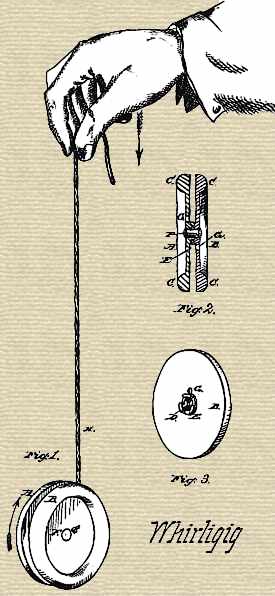
 Class
43.5 Monday,
1/14/19
Class
43.5 Monday,
1/14/19Warm-Up : More Yo-Yo
1. The graphs on the right correspond to one down-up cycle of a yo-yo. How can the yo-yo speed graph be correct if the velocity graph is wrong?
2. When the yo-yo stalls at the lowest point in its path, what kind of PE and KE does it have?
3. Given that a yo-yo is not a 100% efficient device, how does the operator make it come all of the way back to the top? How does this work, in terms of KE and PE?
4. Is there a way to get the yo-yo to return to the hand without adding any extra KE to the yo-yo?
Today:
-
Return quiz -- turn in corrections ASAP, at least before grades are due.
-
Time for questions.
-
Review Stuff
-
Chase Packets
-
Stapleton packets
-
Energy -- our quiz should be good review.
Homework:
-
Midterm
Warm-Up :
None -- start quiz immediately
Today:
-
Practice Quiz (solutions)-- similar to tomorrow's quiz
-
Review Stuff
-
Chase Packets
-
Stapleton packets
-
Energy -- our quiz should be good review.
Online Textbook (OpenStax) Reading:
Homework:
-
Review for the midterm. Next class is your last good chance to ask questions, so be as prepared for that as you can be.
-
Midterm reviews are due on exam day.
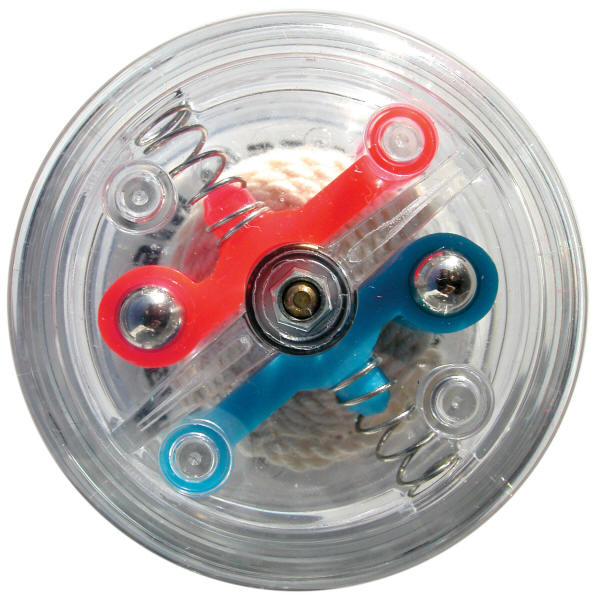 Class
42
Thursday,
1/10/19
Class
42
Thursday,
1/10/19Warm-Up :
1. How does this yo-yo work? What do the springs and steel balls do?
2. Suppose a 100% efficient yo-yo falls down and comes up through
one cycle. Would either (or do both) of these graphs realistically
portray its motion? Explain.

3. What would graphs of KE and PE look like?
Today:
-
Practice Quiz (solutions)-- similar to tomorrow's quiz
-
Review Stuff
-
Chase Packets
-
Stapleton packets
-
Energy -- our quiz should be good review.
Online Textbook (OpenStax) Reading:
Homework:
-
Quiz tomorrow. Tomorrow is a split block, so be ready to start immediately.
Warm-Up :
1. When does each of these energy conservation equations apply to the diagram below?
2. Would your answer change if this were a completely frictionless environment?


Today:
-
Check/review (7-11) of the energy portion of the midterm review packets. Solutions
-
Review Stuff
-
Chase Packets
-
Stapleton packets
-
Energy -- our quiz should be good review.
-
A5/6 -- Midterm Review Work Time
-
A7/8 ?
Online Textbook (OpenStax) Reading:
Homework:
-
None

 Class
40.5
Monday,
1/7/19
Class
40.5
Monday,
1/7/19Warm-Up :
Both graphs represent work that was done over a 3m distance. Estimate the work done in each case.
Today:
-
The Work/Energy quiz will be on Thursday. There will be problems only; no multiple choice. No kinematics formulas will be necessary. There will be one problem involving a roller coaster, a spring, and friction.
-
Check/review Bone on bone hill (with springs) problem Solutions
-
Egg Bungee Jump Activity:
-
If necessary, finish collecting data.
-
Add two new columns to your data table
-
One column showing the new work done during the past stretching interval
-
One column showing the total amount of work done by stretching the bungee to each distance.
-
-
Online Textbook (OpenStax) Reading:
Homework:
-
Complete the rest (7-11) of the energy portion of the midterm review packets.(solutions)
 Class
40
Friday,
1/4/19
Class
40
Friday,
1/4/19Warm-Up :
1. Is tension the same in all parts of the slinky on the right?
2. What happens when you suspend a slinky (as shown in the photo on the right) and then drop it?
3. Why?
Today:
-
Test corrections are due today.
-
Egg Bungee Jump Activity:
-
In groups of 2 or 3, collect Egg Bungee Jump Contest Data -- Create a table of forces and stretch distances for your bungee. Return your bungee.
-
Write down your bungee number
-
One column for hanging mass
-
One column for force applied by hanging mass (i.e. weight)
-
One column for distance stretched (x)
-
Add two new columns to your data table
-
One column showing the new work done during the past stretching interval
-
One column showing the total amount of work done by stretching the bungee to each distance.
-
-
Create a graph showing the total amount of work done by stretching the bungee to any distance, up to the distance at which the bungee reaches the floor. The format should be work vs stretch distance. Work goes on the y axis; stretch distance on the x axis.
-
Online Textbook (OpenStax) Reading:
Homework:
 Class
39.5
Thursday,
1/3/19
Class
39.5
Thursday,
1/3/19Warm-Up :
If we tighten a rope between the end of the board and the digital scale, the digital scale will tell us the tension in the rope. How tight do you think we can get the rope? What's the best way to tighten a rope if you want to be able to untie it later?
Today:
-
Check/review Spring practice problem Solutions -- see my YouTube channel for video solutions
-
Pass out Midterm Review Packets -- Due next Friday. Will count for up to 20% of your exam grade -- if you complete them and show your work.
Online Textbook (OpenStax) Reading:
Homework:
-
Complete 1-6 of the energy portion of the midterm review packets.
-
Test corrections due tomorrow
Warm-Up
:
For an ideal spring, the applied force is directly proportional to the stretch distance*.
The spring constant, k, is the ratio of force to stretch distance. The units we will use for k are N/m.
Suppose a screen door spring has a spring constant k = 40N/m.
1. What is the tension in the spring when it is stretched 1m?
2. What is the tension in the spring when it is stretched 20cm?
3. If we use x for a spring's stretch displacement, derive a formula for the force exerted by the spring. Fspring = ?
3. How much work is required to stretch the spring from a stretch distance of 0m to a stretch distance of 1m?
4. How much work is required to stretch a spring from 0 to x meters if its spring constant is k? In other words, derive the formula for PEspring.
*In the case of a compression spring, x is the compression distance.
Today:
-
Midterm Review Packets (all except work and energy). I am not printing these until Friday. I may make some changes between now and then.
-
Together -- Complete 1-3 in "Spring Energy and Review Problems" (solutions)
Online Textbook (OpenStax) Reading:
Homework:
-
Spring practice problem Solutions -- see my YouTube channel for video solutions
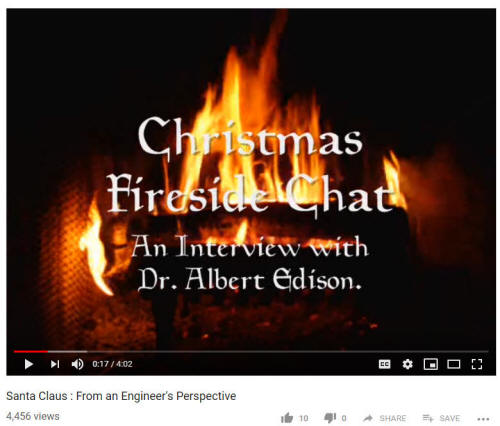 Class
38.5
Friday,
12/21/18
Class
38.5
Friday,
12/21/18 Warm-Up : In order to deliver his presents on time, what forces, accelerations, and other physical obstacles does Santa encounter?
Today:
-
Short Video: Santa Claus from an Engineer's Perspective
-
Midterm Review Packets (all except work and energy)
- Learn to secure a load with a bowline and a Trucker's Hitch (with a slippery half hitch and a slip knot)
-
Online Textbook (OpenStax) Reading:
Homework:
-
None
 Class
38
Thursday,
12/20/18
Class
38
Thursday,
12/20/18 Warm-Up :
A trebuchet's projectile is launched as its counterweight falls, thereby turning PE into KE and accelerating the projectile.
1. Does the projectile do work on the counterweight or vice-versa? Or does each do work on the other? Explain.
2. At which end of the trebuchet arm does the work being done look like this ⇒ Fd ?
3. Record the current temperature, air pressure, and relative humidity.
Today:
-
Launch trebuchet -- collect data to calculate efficiency and drag coefficient.
-
Cantaloupe Measurements:
-
A5/6 -- Average diameter = 0.152m; Mass = 2.00kg
-
A7/8 -- Average diameter = 0.156m; Mass = 1.98kg
-
-
Finish reviewing homework -- #4-10 in "Spring Energy and Review Problems" (solutions)
Online Textbook (OpenStax) Reading:
Homework:
-
None

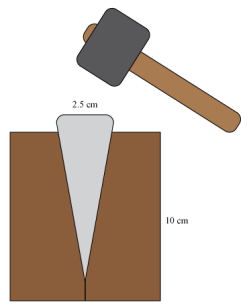

Warm-Up :
The pictures on the right all show simple machines. Simple machines allow the same work to be done with more convenient combinations of force and distance.
1. Identify the task (work) in each picture.
2. For each picture, identify the machine (s).
3. For each machine, tell how the machine alters the distance over which force must be applied by the human using the machine.
4. How does the machine alter the force that the human must apply?
5. Which machine is fundamentally different from the other 3? Why?
Today:
-
For Newton's Laws in 2-D quiz corrections, show your work on separate paper, but write your new answers next to your old answers, using a different colored pen.
-
Check/review homework -- #4-10 in "Spring Energy and Review Problems" (solutions)
Online Textbook (OpenStax) Reading:
Homework:
-
None
 Class
37 Tuesday,
12/18/18
Class
37 Tuesday,
12/18/18Warm Up:
1. What does the "sisyphus train" do?
2. How did it get that nickname?
3. In the context of physics energy problems, some forces are called conservative, and others are referred to as non-conservative. Can you guess the difference between the two?
Today:
-
Check/review homework #5
-
Finish notes -- Energy and Work. Answers/solutions
-
Complete and discuss:
-
Problem #6 in Energy and Work.
-
?Problems in Practice Quiz Excel Solutions
-
Online Textbook (OpenStax) Reading:
Homework:
-
Complete #4-10 in "Spring Energy and Review Problems" (solutions)
 Class
36.5 Monday,
12/17/18
Class
36.5 Monday,
12/17/18Warm Up:
1. What is the difference between kinetic energy and potential energy?
2. A 1kg ball travels directly upward. Its initial KE = 8J. How much kinetic energy will it have when it reaches its highest point? (ignore air resistance)
3. How much potential energy (PE) will it have when it reaches its highest point?
4. As the ball rises, what is doing work on what?
5. What is the formula for gravitational PE, and where does it come from?
Today:
-
Return Tezts
-
?Work on homework
-
?Notes on Conservation of Energy with and without Nonconservative Forces -- Energy and Work. Answers/solutions
Online Textbook (OpenStax) Reading:
Homework: Complete Problem #5 in Energy and Work. Answers/solutions
Warm Up:
None
Today:
-
Test
Online Textbook (OpenStax) Reading:
Homework: None
 Class
35.5 Thursday,
12/13/18
Class
35.5 Thursday,
12/13/18Warm Up:
1. What is the purpose of a centrifuge?
2. Can you use a bathroom scale to find the weight of the Earth?
Today:
-
Check/review homework: Problems 1-4 from Work and Energy. Answers/solutions
-
What to expect from the test -- Test review checklist
Online Textbook (OpenStax) Reading:
Homework:
-
Little test/big quiz tomorrow.

 Class
35 Wednesday,
12/12/18
Class
35 Wednesday,
12/12/18Warm Up:
1. How are g-forces dangerous to pilots?
2. In this video, a driver attempts to traverse a large loop-the-loop. In order to safely complete his mission, how many g's do you suppose the driver needs to tolerate?
Today:
-
Any more questions about the homework that was assigned two days ago? -- More practice-- Circular Motion, Gravitation, Kepler Solutions
-
New Unit Notes: Work and Energy. Answers/solutions
Online Textbook (OpenStax) Reading:
Homework:
-
Problems 1-4 from Work and Energy. Answers/solutions
 Class
34.5 Tuesday,
12/11/18
Class
34.5 Tuesday,
12/11/18Warm Up:
1. Approximately how fast is the jogger in this video moving, relative to the center of rotation?
2. If the jogger turned around and jogged the other way, would he feel any different?
3. Identify a centripetal force and a centrifugal force in this video.
Today:
-
Check/review homework -- 1 hour of work on More practice-- Circular Motion, Gravitation, Kepler Solutions
Online Textbook (OpenStax) Reading:
Homework:
-
Finish More practice-- Circular Motion, Gravitation, Kepler Solutions
-
Little test/big quiz on Friday. The test will cover circular motion, gravitation, and Kepler's Laws.
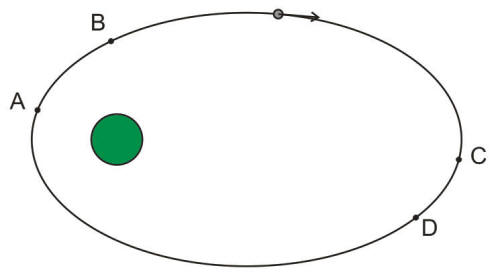 Class
34 Monday,
12/10/18
Class
34 Monday,
12/10/18Warm Up:
1. Does it take longer for the satellite to travel from point A to point B or from point C to point D? How do you know?
2.

3. What is a geosynchronous satellite?
4. What's the difference between a geosynchronous orbit and a geostationary orbit?
5. What is a space elevator?
Today:
-
Check/review homework -- problems from Practice -- Mr. Pennington's 2015 test. Solutions (although #5 and #7 are in radians). Video tips on solving the problems, including 5 and 7 in linear terms.
-
Get -- More practice-- Circular Motion, Gravitation, Kepler Solutions
Online Textbook (OpenStax) Reading:
Homework:
-
Spend at least an hour on this. You can stop after an hour, even if you're not done. -- More practice-- Circular Motion, Gravitation, Kepler Solutions
-
Little test/big quiz on Friday. The test will cover circular motion, gravitation, and Kepler's Laws.

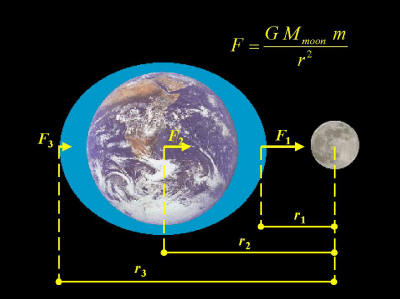 Class
33.5 Friday,
12/7/18
Class
33.5 Friday,
12/7/18Warm Up:
From 2016-2017 EPS 200...
The Sun, Earth, and Moon are continually spaghettifying one another. On Earth, we see the effects of this spaghettification in the form of tides.
1. What causes spaghettification?
2. How much gravitational force do the Sun and Moon each exert on 1,000,000 pounds of water?
3. Even if there were no water on Earth, there would still be tides, just as there are tides on the Moon. Describe these tides.
4. Why do we always see the same side of the moon?
5. Is the Earth's 24 hour rotational period speeding up or slowing down over time? Answer
Today:
-
Check/review homework
-
#14 and 15 from Notes: Circles, Gravity, Kepler Solutions
-
-
T
Online Textbook (OpenStax) Reading:
Homework:
-
Complete the problems from Practice -- Mr. Pennington's 2015 test. Solutions (although #5 and #7 is in radians). Video tips on solving the problems, including 5 and 7 in linear terms.
-
Little test/big quiz next Wednesday. The test will cover circular motion, gravitation, and Kepler's Laws.
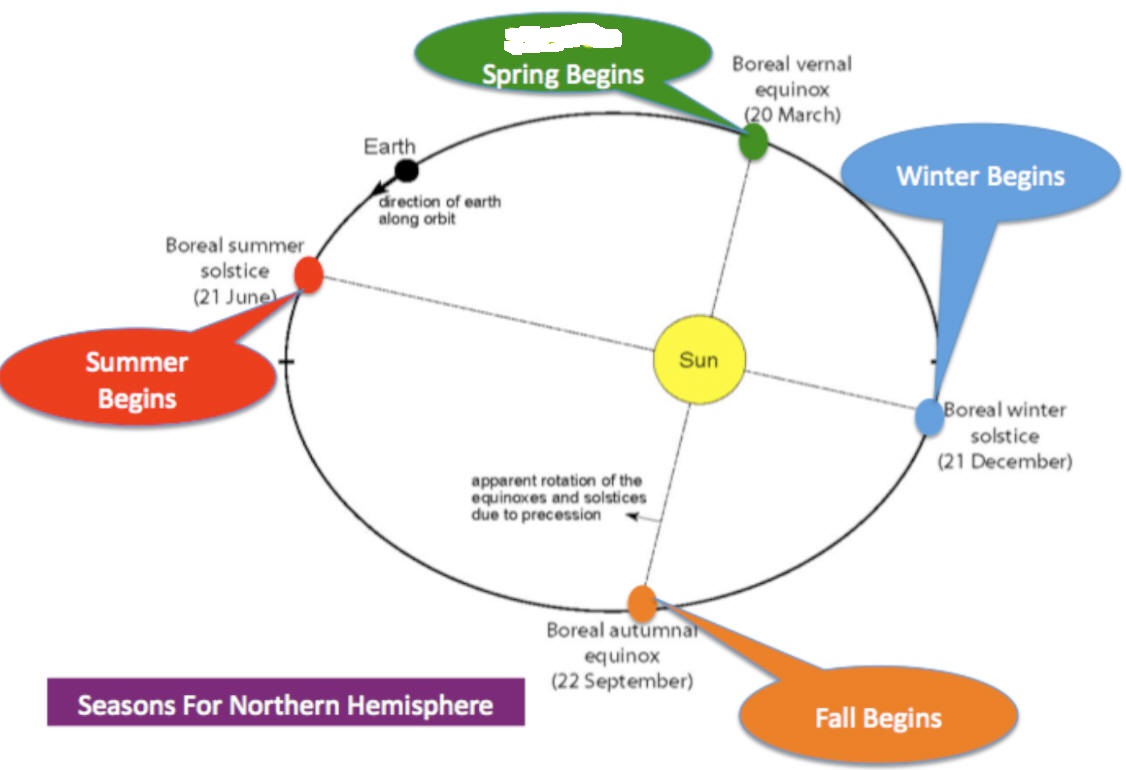 Class
33 Thursday,
12/6/18
Class
33 Thursday,
12/6/18Warm Up:
1. At what approximate date is the Earth orbiting with the fastest speed? When is it orbiting the slowest?
2. Rank our seasons in order of length. Answer
3. How are our solstice and equinox dates determined?
Today:
-
Check/review homework -- Elliptical Orbits Activity

-
Finish Notes -- Kepler's 1st and 3rd Laws -- Notes: Circles, Gravity, Kepler Solutions solution to #10 with 3rpm
Online Textbook (OpenStax) Reading:
Homework:
-
#14 and 15 from Notes: Circles, Gravity, Kepler Solutions
-
Complete the multiple choice section of Practice -- Mr. Pennington's 2015 test. Solutions (although #5 and #7 is in radians). Video tips on solving the problems, including 5 and 7 in linear terms.
 Class
32.5 Wednesday,
12/5/18
Class
32.5 Wednesday,
12/5/18Warm Up:
Are astronauts weightless when they are in the international space station? Is this candle weightless?
Today:
-
Check/review homework. Notes: Circles, Gravity, Kepler Solutions solution to #10 with 3rpm
-
Kepler's Laws
Online Textbook (OpenStax) Reading:
Homework: Finish the elliptical orbits activity. Elliptical Orbits Activity
 Class
32 Tuesday,
12/4/18
Class
32 Tuesday,
12/4/18Warm Up: Hank is carrying a very wide tray of sand that won't fit through a doorway. How can Hank get the tray through the doorway without spilling the sand?
Today:
-
Do you have a zero for your home run problem or your rocket analysis?
-
Check homework. Notes: Circles, Gravity, Kepler Solutions solution to #10 with 3rpm
-
Newton's law of Gravitation
Online Textbook (OpenStax) Reading:
Homework: The following can be found in Notes: Circles, Gravity, Kepler Solutions solution to #10 with 3rpm
-
Complete whatever remains of "circular motion example problems 1-2" or "circular motion practice problems 1-3"
-
Complete "various practice problems" 11-13.
 Class
31.5 Monday,
12/3/18
Class
31.5 Monday,
12/3/18Warm Up:
Consider an object tied to a string that is being swung in horizontal circles. What forces are acting on the object? What forces are acting on the string?
Today:
-
Return things
-
Chapter 6 (Circular Motion and Gravitation)
-
Brief look in online textbook -- Chapter 6.2 -- Centripetal Acceleration
-
Notes: Circles, Gravity, Kepler Solutions solution to #10 with 3rpm
-
Online Textbook (OpenStax) Reading:
Homework:
-
Problem #10 of "various problems" in Notes: Circles, Gravity, Kepler Solutions solution to #10 with 3rpm
 Class
31 Friday,
11/29/18
Class
31 Friday,
11/29/18Warm Up:
If you made a hole straight through the Earth, where would the hole come out on the other side?
Today:
-
Quiz
-
Test corrections due today
-
Chapter 6 (Circular Motion and Gravitation)
-
Brief look in online textbook -- Chapter 6.2 -- Centripetal Acceleration
-
Notes: Circles, Gravity, Kepler Solutions solution to #10 with 3rpm
-
Online Textbook (OpenStax) Reading:
Homework:
-
none
 Class 30.5
Thursday,
11/29/18
Class 30.5
Thursday,
11/29/18Warm Up:
According to physics lore, if you made a hole through the center of the Earth, and jumped in, you would readch the other side in approximately 42 minutes (assuming no friction).
1. How could this be calculated using Newton's Law of Gravitation?

2. It turns out that the trip would not actually take 42 minutes. Why? Would the trip actually be longer or shorter?
3. What if there were air resistance?
4. Where would you come out?
Excel spreadsheet -- falling through the earth
Today:
-
Please change your spreadsheet share settings to "anyone at ewsd with a link"
-
Review homework -- Another practice quiz -- from two years ago. Video showing solutions
-
Begin Chapter 6 (Circular Motion and Gravitation)
-
Brief look in online textbook -- Chapter 6.2 -- Centripetal Acceleration
-
Notes: Circles, Gravity, Kepler Solutions solution to #10 with 3rpm
-
Online Textbook (OpenStax) Reading:
Homework:
-
Corrections for Test 3 (Newton's Laws in 1-D) due tomorrow
-
Quiz tomorrow over Newton's Laws in 2-D.
 Class 30 Wednesday,
11/28/18
Class 30 Wednesday,
11/28/18Warm Up:
A Google search result says the acceleration of gravity on Earth is 9.807m/s2. For multiple reasons,that is almost always not the precise acceleration of a falling object.
1. What are those reasons?
2. When would this be the exact acceleration of a falling object?
Today:
-
Check/review homework -- Practice Quiz over Newton's Laws in 2-D. Spreadsheet solutions to practice quiz
-
Return papers -- there's a video on my youtube channel that will help you with the rocket analysis number 11
-
Another practice quiz -- from two years ago. Video showing solutions
Online Textbook (OpenStax) Reading:
Homework:
-
Due on Friday, 11/30: Corrections for Test 3 (Newton's Laws in 1-D)
-
Optional -- Another practice quiz -- from two years ago. Video showing solutions
-
Quiz on Friday over Newton's Laws in 2-D.
 Class
29.5 Tuesday,
11/27/18
Class
29.5 Tuesday,
11/27/18Warm Up:
A waiter is carrying a chunk of bone, basted with synovial fluid, on a flat, bone tray. The tray is angled at 45º, as shown. Why doesn't the bone chunk slip off of the tray? What would the waiter need to do in order to stop and turn around, without touching the bone, and without cau
Today:
-
Distribute Donuts
-
Check/review homework -- Masses Hanging and Dragged at Angles Solutions to #1 and #2 solutions to #3 and #4
-
Return baseball home run problem -- discuss grading
Online Textbook (OpenStax) Reading:
-
4.5 Normal, Tension, and Other Examples of Forces
-
4.6 Problem-Solving Strategies
-
4.7 Further Applications of Newton’s Laws of Motion
Homework:
-
Due on Friday, 11/30: Corrections for Test 3 (Newton's Laws in 1-D)
-
Practice Quiz over Newton's Laws in 2-D. Spreadsheet solutions to practice quiz Due tomorrow.
-
Quiz on Friday over Newton's Laws in 2-D.
 Class
29 Monday,
11/26/18
Class
29 Monday,
11/26/18Warm Up:
A 1kg mass is suspended by a string from the ceiling of a train car. The front and rear of the car are open, so the mass is exposed to the oncoming wind. The velocity of the train and the angle in the diagram both remain constant. [Air density = 1.2kg/m3. Cd sphere = 0.45. Asphere = 0.05m2]
1. How would we draw the forces acting on the sphere?
2. Given g = 10m/s2, what is the tension in the string?
3. What is the velocity of the train?
Today:
-
Check/review homework Bodies on Inclines (abbreviated) Answers (and some solutions ) to Bodies on Inclines
-
Donuts tomorrow
-
Turn in the rest of your assignments:
-
Water rocket analysis (one per group) -- put it in the wire basket
-
Your projectile with drag spreadsheet. Submit a link using this form.
-
Most efficient home run. Put your sheet in the wire basket.
-
-
Masses Hanging and Dragged at Angles Solutions to #1 and #2 solutions to #3 and #4
Online Textbook (OpenStax) Reading:
-
4.5 Normal, Tension, and Other Examples of Forces
-
4.6 Problem-Solving Strategies
-
4.7 Further Applications of Newton’s Laws of Motion
Homework:
-
Complete the rest of Masses Hanging and Dragged at Angles Solutions to #1 and #2 solutions to #3 and #4
-
Due on Friday, 11/30: Corrections for Test 3 (Newton's Laws in 1-D)
 Class
28 Thursday,
11/15/18
Class
28 Thursday,
11/15/18Warm Up:
The picture on the right shows how a chain can be used to pull a stuck car out of the mud. All that is required is a small sideways force applied to the center of the chain. Why does this work?
Today:
-
Intro to Bodies on Inclines (abbreviated) Answers (and some solutions ) to Bodies on Inclines Low resolution video from 2 years ago (first page of handout)
-
Enter your rocket flight times into the form (Rocket contest results)
-
Work time.
Assignment Due Dates:
-
Due tomorrow (11/16) -- Water Rocket Analysis (with your partner)
-
Due tomorrow (11/16) -- As a group, finish and debug your own spreadsheet and submit it using this form.
-
Due tomorrow (11/16) -- Complete individually. Most efficient home run.Video help, part 1 Video help, part 2 (the graph)
-
Due on Monday after break (11/26) -- Ordinary homework -- Bodies on Inclines (abbreviated) Answers (and some solutions ) to Bodies on Inclines
-
Due on Friday, 11/30: Corrections for Test 3 (Newton's Laws in 1-D)
Warm Up:
1. How does Clifford Heath's water rocket simulator work? What can we learn from it?
2. How could you modify your spreadsheet to calculate: 1) "crashdown speed?" 2) Δx?
Today:
-
Work on the Water Rocket Analysis (with your partner) -- Due tomorrow..
-
Here's a link to your rocket pre-launch data that you submitted before we launched.a
-
Link to Clifford Heath's Water rocket simulator
-
-
Get the home run problem (due on Friday)
Assignment Due Dates: These assignments are not optional. If you do not complete them, they will count as zeroes.
-
Due on Thursday (11/15) -- As a group, finish and debug your own spreadsheet and submit it using this form.
-
Due on Thursday (11/15) -- Water Rocket Analysis (with your partner)
-
Due on Friday (11/16) -- Complete individually. Most efficient home run.
 Class
27 Tuesday,
11/13/18
Class
27 Tuesday,
11/13/18
Warm Up: Two
boxes are initially at rest, relative to a the elevator in which they
sit.
When
a
person exerts a 200N rightward force over a time interval of 1 second,
the 20kg box moves a distance of 1.38m rightward.
What is the
10kg block's
x displacement
during that same time interval?
Today:
-
Bonus problem solutions should be turned in.
-
Work on the Water Rocket Analysis (with your partner) -- Due on Wednesday.
-
Here's a link to your rocket pre-launch data that you submitted before we launched.
-
Assignment Due Dates: These assignments are not optional. If you do not complete them, they will count as zeroes.
-
Due on Thursday (11/15) -- As a group, finish and debug your own spreadsheet and submit it using this form.
-
Due on Thursday (11/15) -- Water Rocket Analysis (with your partner)
-
Due on Friday (11/16) -- Complete individually. Most efficient home run.
 Class
26.5 Monday,
11/12/18
Class
26.5 Monday,
11/12/18Warm Up:
Suppose someone straps a stuffed koala to a rocket and then launches the koala and rocket directly upward. The rocket thrust lasts for 1 second and provides a constant force of 1,000N. During thrust, the average mass of the koala + engine + fuel + harness = 10kg.
Ignoring air resistance, calculate the maximum height reached by the koala? For ease, you can assume that g=10m/s2.
Today:
-
7/8 --
-
Turn in and review previous homework (I forgot about it on Friday)
-
Column Q and the orange cells
-
Time aloft formula -- undo the fix that I mentioned in last class. Talk about why.
-
-
-
Work on the Water Rocket Analysis (with your partner) -- Due on Wednesday.
-
Here's a link to your rocket pre-launch data that you submitted before we launched.
-
Tomorrow: Work time to finish whatever you need to finish.
Assignment Due Dates: These assignments are not optional. If you do not complete them, they will count as zeroes.
-
Due on Thursday (11/15) -- As a group, finish and debug your own spreadsheet and submit it using this form.
-
Due on Thursday (11/15) -- Water Rocket Analysis (with your partner)
-
Due on Friday (11/16) -- Complete individually. More applications of the projectile with drag spreadsheet
-
Most efficient home run: Video help, part 1 Video help, part 2 (the graph)
-
What is the minimum speed at which a baseball must leave a bat in order to reach the fence (in the air) 340 feet away? What is the angle for this hit? Assume that the density of the air is 1.22kg/m3, the mass of the baseball is 0.145kg, the circumference of the ball is 0.23m, and the ball's drag coefficient is 0.45.
-
Create a graph of Y position vs X position to show this baseball's flight path. Adjust the X and Y axes so that the scales are approximately equal and, therefore, the shape of the flight path is undistorted.
-
-
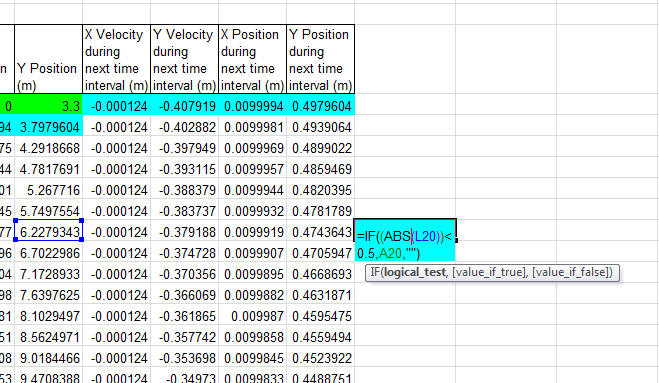 Class
26 Friday,
11/9/18
Class
26 Friday,
11/9/18Warm Up:
1. What purpose does the formula in column Q serve?
2. Why don't the first several rows in column Q have formulas?
Today:
-
Check homework
-
Important notes for finishing your own spreadsheet (due Tuesday)
-
Column Q and the orange cells
-
Time aloft formula -- undo the fix that I mentioned in last class. Talk about why.
-
-
Modifying the Xdrag formula to improve spreadsheet versatility.
-
-
Collect data for the Water Rocket Analysis (with your partner)
Homework:
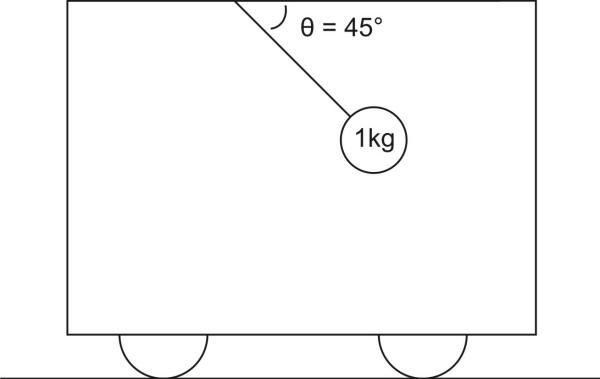 Class
25.5 Thursday,
11/8/18
Class
25.5 Thursday,
11/8/18Warm Up:
A 1kg mass is suspended by a string from the ceiling of a train car. The angle shown remains constant.
1. Describe the motions of the mass and the train car in qualitative terms.
2. How can we find the tension in the string?
3. How can we describe the motions of the mass and the train car in quantitative terms.
Today:
-
Look at tests. Until everyone has taken the test (?), come to flex to work on corrections.
-
The mysterious column Q, and the orange cells -- fix for time aloft.
-
If you have a partner, share your spreadsheet, and make your own personal copy.
-
Finish the spreadsheet to analyze a projectile (e.g. a coasting rocket) that is experiencing drag.
Homework:
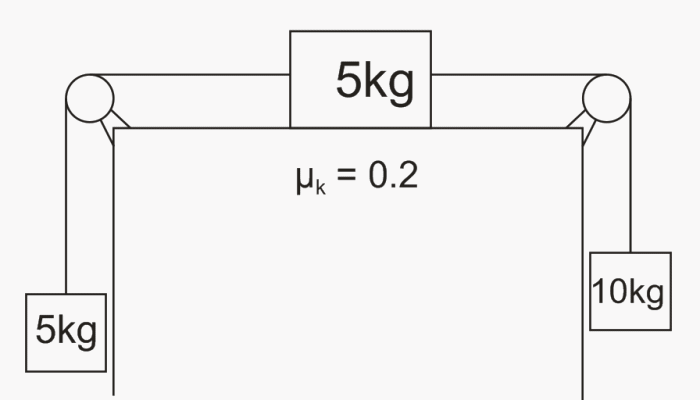 Class
24.5 Tuesday,
11/6/18
Class
24.5 Tuesday,
11/6/18Warm Up:
Find the acceleration of each block and the tensions in the two strings. To make your work easier, use g=10m/s2
Assume that the pulleys and strings are massless and frictionless.
Today:
-
Student led test review -- until it there are no more questions
-
A5/6 -- one Gucci/Supreme rocket to disassemble
-
The mysterious column Q, and the orange cells.
-
Finish the spreadsheet to analyze a projectile (e.g. a coasting rocket) that is experiencing drag.
Homework:
-
Test on Wednesday.
-
Options: 1) note card of your making 2) provided formulas 3) Neither note card nor formulas, plus approximately 3% extra credit -- you must commit to this before the test.
-
Begin making a "note card" if you want one. Requirements/limitations: no more than 80in2 of surface area; original handwritten copy, created by you.
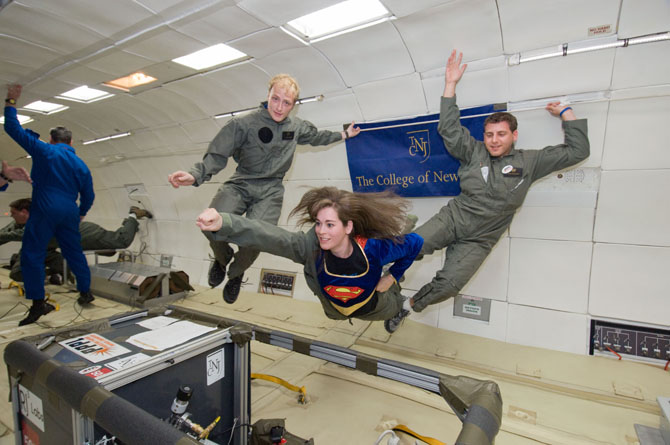 Class
24 Monday,
11/5/18
Class
24 Monday,
11/5/18Warm Up:
1. How does NASA simulate weightlessness?
2. You are trying to transfer some drippy sauce across a dinner table using only a drippy spoon. The sauce needs to go from the pot to your plate without dripping. Touching only the spoon, how can you make this happen?
3. What would happen if you were standing on a bathroom scale in an elevator, and the elevator suddenly began to accelerate downward at 1g?
4. What is the source of the "butterflies in the stomach" when we fall?
Today:
-
A7/8 -- two more rockets to disassemble.
-
Create a spreadsheet to analyze a projectile (e.g. a coasting rocket) that is experiencing drag.
Homework:
-
Test on Wednesday.
-
Options: 1) note card of your making 2) provided formulas 3) Neither note card nor formulas, plus approximately 3% extra credit -- you must commit to this before the test.
-
Begin making a "note card" if you want one. Requirements/limitations: no more than 80in2 of surface area; original handwritten copy, created by you.
 Class
23.5 Friday,
11/2/18
Class
23.5 Friday,
11/2/18Warm Up: The figure on the right shows Atwood's Machine. Write an equation for the acceleration of the masses in terms of m1, m2, and g. You may assume that the rope is massless and that there is no friction.
Today:
-
Check/review homework: Some more practice questions/ problems. Solutions
-
Test review.
-
A7/8 -- two more rockets to disassemble.
-
Create a spreadsheet to analyze a projectile (e.g. a coasting rocket) that is experiencing drag.
Homework:
-
Test on Wednesday.
-
Options: 1) note card of your making 2) provided formulas 3) Neither note card nor formulas, plus approximately 3% extra credit -- you must commit to this before the test.
-
Begin making a "note card" if you want one. Requirements/limitations: no more than 80in2 of surface area; original handwritten copy, created by you.
-
 Class
23 Thursday,
11/1/18
Class
23 Thursday,
11/1/18Warm Up: If you need to stop a car quickly, why should you avoid locking the tires or skidding?
Today:
-
Check/review homework: Complete Practice Test: Newton's Laws in 1-D through problem #5. Answers but not solutions Problem Solutions
-
Test review.
-
A7/8 -- two more rockets to disassemble.
-
Create a spreadsheet to analyze a projectile (e.g. a coasting rocket) that is experiencing drag.
Homework:
-
Finish the handout from class today -- Some more practice questions/ problems. Solutions
Test on Wednesday.
-
Options: 1) note card of your making 2) provided formulas 3) Neither note card nor formulas, plus approximately 3% extra credit -- you must commit to this before the test.
-
Begin making a "note card" if you want one. Requirements/limitations: no more than 80in2 of surface area; original handwritten copy, created by you.
-
Warm Up: What if I put a large rock on my head, with a 2"x4" on top of the rock, and then I have someone hammer a large nail through the 2"x4"? Is this a good idea?
Today:
-
Test #2 corrections are due today.
-
Test on Monday, over Newton's Laws in 1-D. There will not be an extended problem on the test (like #6 on the practice test).
-
Check/review homework. Complete problem #7 from Practice Test: Newton's Laws in 1-D Answers but not solutions Problem Solutions
Homework:
-
Complete Practice Test: Newton's Laws in 1-D through problem #5. Answers but not solutions Problem Solutions
-
Test on Monday.
-
Options: 1) note card of your making 2) provided formulas 3) Neither note card nor formulas, plus approximately 3% extra credit -- you must commit to this before the test.
-
Begin making a "note card" if you want one. Requirements/limitations: no more than 80in2 of surface area; original handwritten copy, created by you.
-
 Class
22 Tuesday,
10/30/18
Class
22 Tuesday,
10/30/18Warm Up: How many 100 psi water bottles would it take to launch a human?
Today:
-
Measure rockets. Fill out rocket data form.
-
Prepare rockets for launching. Replace anything that shouldn't be part of your rocket.
-
Take a few bottles of extra water in case some launches fail.
-
Disassemble rockets
Homework:
-
None
 Class
21.5 Monday,
10/29/18
Class
21.5 Monday,
10/29/18Warm Up:
1. If a Wiffle® Ball has a mass of about 45g, what is the upper limit of the amount of force a thrower can apply to a Wiffle Ball during the throw?
2. Why is there a limit to how much force can be applied to a thrown Wiffle Ball?
Today:
-
Check/review homework:
-
Multibody Drill A Problems 2 and 6 Multibody Drill A Solutions -- Stapleton Video for problem 2 Video for problem 6
-
Complete conceptual questions 6-8 from Practice Test: Newton's Laws in 1-D Answers but not solutions Problem Solutions
-
-
Check out the rockets. We will launch them tomorrow.
Online Textbook (OpenStax) Reading:
- Ch 4.4: Newton's 3rd Law, Symmetry in Forces
- Ch 4.5: Normal, Tension, and Other Examples of Force
- Ch 5.1: Friction
Homework:
-
If you need a new weight for your rocket, get a rock or a battery.
-
Complete problem #7 from Practice Test: Newton's Laws in 1-D Answers but not solutions Problem Solutions
-
Test #2 corrections are due by Wednesday.
 Class
21 Friday,
10/26/18
Class
21 Friday,
10/26/18Warm Up:
Emergency clinic records of 132 cats that jumped from windows of buildings showed a 90% survival rate. The average drop was 5.5 floors.
1. When does a falling cat experience zero net force?
2. When is a falling cat a "free-falling" cat?
3. When does a falling cat experience maximum net force?
Today:
-
Check/review homework: Practice with forces in 1 dimension -- The rest of the problems (36-47). Answers/solutions
-
A7/8 -- Filled-in 3rd law notes If you want to complete the back side of the 3rd law notes, open the link and complete them on your own.
-
Redo multibody example, with µk = 0.3
Online Textbook (OpenStax) Reading:
- Ch 4.4: Newton's 3rd Law, Symmetry in Forces
- Ch 4.5: Normal, Tension, and Other Examples of Force
- Ch 5.1: Friction
Homework:
-
Multibody Drill A Problems 2 and 6 Multibody Drill A Solutions -- Stapleton Video for problem 2 Video for problem 6
-
Complete conceptual questions 6-8 from Practice Test: Newton's Laws in 1-D Answers but not solutions Problem Solutions
-
Test #2 corrections are due by 10/31
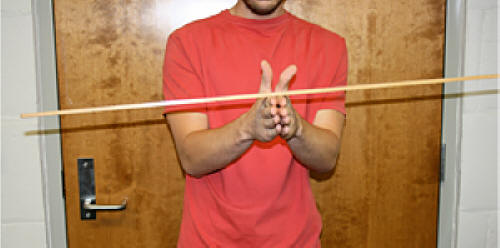 Class
20.5 Thursday,
10/25/18
Class
20.5 Thursday,
10/25/18Warm Up:
One way to find the center of mass (a.k.a. balance point) of a stick is to support it with two hands and then slowly move those two hands together until they meet under the stick's center of mass.
Why does this method work?
Today:
-
Review homework: Multibody Drill A Problems 1, 3, 4, and 5 Multibody Drill A solutions -- Stapleton
-
A7/8 -- Finish 3rd law notes?
-
Redo multibody example, with µk = 0.3
-
Work time?
Online Textbook (OpenStax) Reading:
- Ch 4.4: Newton's 3rd Law, Symmetry in Forces
- Ch 4.5: Normal, Tension, and Other Examples of Force
- Ch 5.1: Friction
Homework:
-
Test #2 corrections are due by 10/31
 Class 20
Wednesday,
10/24/18
Class 20
Wednesday,
10/24/18Warm Up:
1. In a game of tug-of-war, who pulls the hardest -- the winners, the losers, or neither? Explain.
2. Why is the word pull in italics?
Today:
-
Discuss rockets -- launch and collect data next week
-
Discuss transferrable skills -- work completion, engagement, creative and practical problem solving
-
Check/review homework
-
Practice with forces in 1 dimension -- Conceptual Questions 13 and 15, and Problem 15. Answers/solutions
-
Multibody Drill A Problems 1, 3, 4, and 5 Multibody Drill A solutions -- Stapleton
-
-
A7/8 -- Finish 3rd law notes
-
Both classes -- Friction notes
-
Work time
Online Textbook (OpenStax) Reading:
- Ch 4: Newton's Laws Intro
- Ch 4.1: Force
- Ch 4.2: Newton's 1st Law, Inertia
- Ch 4.3: Newton's 2nd Law, Concept of a System
- Ch 4.4: Newton's 3rd Law, Symmetry in Forces
- Ch 4.5: Normal, Tension, and Other Examples of Force
- Ch 5.1: Friction
Homework:
-
Practice with forces in 1 dimension -- The rest of the problems (36-47). Answers/solutions
-
Test #2 corrections are due by 10/31
Warm Up: None
Today:
-
Finish your rockets and homework.
-
Determine the optimal amount of water for your water rocket, using a Water rocket simulator such as this one. If you do use this simulator, don't forget to enter "100p" for pressure.
Online Textbook (OpenStax) Reading:
- Ch 4: Newton's Laws Intro
- Ch 4.1: Force
- Ch 4.2: Newton's 1st Law, Inertia
- Ch 4.3: Newton's 2nd Law, Concept of a System
- Ch 4.4: Newton's 3rd Law, Symmetry in Forces
- Ch 4.5: Normal, Tension, and Other Examples of Force
- Ch 5.1: Friction
Homework: Due on Wednesday:
-
Practice with forces in 1 dimension -- Conceptual Questions 13 and 15, and Problem 15. Answers/solutions
-
Multibody Drill A Problems 1, 3, 4, and 5 Multibody Drill A solutions -- Stapleton
-
Optional -- textbook reading (see above)
Warm Up: None
Today:
1) Watch this video. Make sure that you adjust the three volume controls: 1) computer volume, 2) YouTube volume, 3) Stereo Receiver volume
2) Work on Rockets:
-
In pairs, design and build a water rocket. There can only be one non-pair group per class. That one group can be a single person or a group of 3.
-
Each pair gets no more than two bottles. One bottle is for spare parts, and the other bottle is for the pressure chamber. The pressure chamber bottle must not be cut into or compromised in any way. A good rocket will need nice fins near the back, a weight on the front, an aerodynamic design, and radial symmetry (when viewed from the nose).
-
You may want to use a water rocket simulator, like this one [Water rocket simulator -- enter "100p" for pressure.], to determine the optimal "empty mass" of your rocket. You should definitely determine the optimal amount of water for your rocket (@100psi)
-
Rocket goals and requirements:
-
Goal: maximum height
-
Flight is straight up and straight down. No parachutes.
-
No more than 1m of duct tape may be used.
-
You must construct your rocket in such a way that you can disassemble it and recycle all recyclable components (and reuse all reusable components). Duct tape is not recyclable.
-
-
Rocket Materials Locations:
-
Bottles go bags in the back of the room.
-
Scissors are kept in one of the teacher desk drawers (left side)
-
Duct tape goes in the top left teacher desk drawer.
-
Store your rocket (and/or rocket parts) in a cabinet beneath a lab table.
-
Trash (bottle labels and ruined duct tape) goes in the trash can
-
Recycling goes in the recycling bin
-
3) Work on the homework (below)
Online Textbook (OpenStax) Reading:
- Ch 4: Newton's Laws Intro
- Ch 4.1: Force
- Ch 4.2: Newton's 1st Law, Inertia
- Ch 4.3: Newton's 2nd Law, Concept of a System
- Ch 4.4: Newton's 3rd Law, Symmetry in Forces
- Ch 4.5: Normal, Tension, and Other Examples of Force
- Ch 5.1: Friction
Homework: Due on Wednesday:
-
Practice with forces in 1 dimension -- Conceptual Questions 13 and 15, and Problem 15. Answers/solutions
-
Multibody Drill A Problems 1, 3, 4, and 5 Multibody Drill A solutions -- Stapleton
-
Optional -- textbook reading (see above)
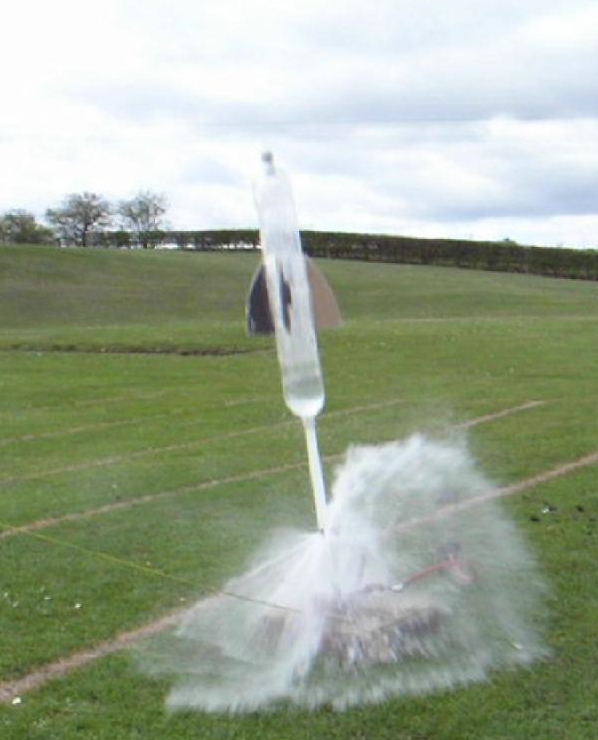 Class 18.5
Wednesday,
10/17/18
Class 18.5
Wednesday,
10/17/18Warm Up:
1. How does a water rocket work?
2. Would a water rocket work better or worse in outer space? Explain.
Today:
-
Check/review homework: Practice with forces in 1 dimension -- Problems 10, 13, 14. Answers/solutions
-
Multibody drill A practice problem
-
Note about elevator problem
Online Textbook (OpenStax) Reading:
- Ch 4: Newton's Laws Intro
- Ch 4.1: Force
- Ch 4.2: Newton's 1st Law, Inertia
- Ch 4.3: Newton's 2nd Law, Concept of a System
Homework:
- Bring in a weight for a water rocket. A rock will work. A good one would be a cylindrical rock that is about 1" in diameter and 2-3 inches long. I think 50 grams is okay, but that may not be right.
- Due on Wednesday:
- Practice with forces in 1 dimension -- Conceptual Questions 13 and 15, and Problem 15. Answers/solutions
- Multibody Drill A Problems 1, 3, 4, and 5 Multibody Drill A solutions -- Stapleton
Warm Up: Take a look at the 2-D kinematics data relating to homework completion and test scores. What do you think?
Means: 68% (A5/6), 84% (A7/8) Medians: 63% (A5/6), 88% (A7/8)
Today:
-
Return Tests: Test corrections for Chapter 3 (2-D Kinematics) are due by 10/31. For multiple choice questions, you must explain the reasoning behind your answer choice.
-
Check/review homework -- Practice with forces in 1 dimension -- Conceptual questions 3-10. Problems 1-9. Answers/solutions
-
Notes: 3rd Law, Tension Filled-in 3rd law notes
-
Tension
-
Multibody drill A practice problem
-
-
Mr. Stapleton will be gone on Monday and Tuesday. He will leave you some physics problems.
Online Textbook (OpenStax) Reading:
- Ch 4: Newton's Laws Intro
- Ch 4.1: Force
- Ch 4.2: Newton's 1st Law, Inertia
- Ch 4.3: Newton's 2nd Law, Concept of a System
Homework:
- Practice with forces in 1 dimension -- Problems 10, 13, 14. Answers/solutions
Warm Up:
There is a heavy object suspended from the ceiling by a string. Another segment of the from the same roll of string is hanging from the object. I am going to pull on the bottom string until one of the two strings breaks. Which string is going to break first? Why?
Today:
-
Hopefully tests will be returned tomorrow. There are still too many that have not been completed.
-
Notes -- Newton's 1st and 2nd Laws Filled-In Notes
Online Textbook (OpenStax) Reading:
- Ch 4: Newton's Laws Intro
- Ch 4.1: Force
- Ch 4.2: Newton's 1st Law, Inertia
- Ch 4.3: Newton's 2nd Law, Concept of a System
Homework:
- Practice with forces in 1 dimension -- Conceptual questions 3-10. Problems 1-9. Answers/solutions
Warm Up:
Test Today. No Warm-up.
Today: Chapter 3 Test
Online Textbook (OpenStax) Reading:
- Ch 4: Newton's Laws Intro
- Ch 4.1: Force
- Ch 4.2: Newton's 1st Law, Inertia
- Ch 4.3: Newton's 2nd Law, Concept of a System
Homework:
- None
 Class 16
Thursday,
10/11/18
Class 16
Thursday,
10/11/18Warm Up:
1. It is possible to remove a sheet paper from under a dry erase pen without touching or tipping the pen. How can one do this without tipping the pen? Why does the pen usually fall?
2. 1m/s = ____ mph. For tomorrow's test, memorize this or be able to calculate it based on a known conversion.
Today:
-
Projectile Launcher Competition Results Discuss donut preferences, missing names, and missing papers.
-
Questions about the test? What do you want to review?
-
Preview of next unit?
Online Textbook (OpenStax) Reading:
- Ch 4: Newton's Laws Intro
- Ch 4.1: Force
- Ch 4.2: Newton's 1st Law, Inertia
- Ch 4.3: Newton's 2nd Law, Concept of a System
Homework:
- Prepare for Friday's test.
Warm Up:
No Warm-up
Today:
-
Projectile Launcher Competition
-
As a group -- Turn-in your sheet with attached graph
Online Textbook (OpenStax) Reading:
Homework:
- Prepare for Friday's test.
Warm Up:
No Warm-up
Today:
-
Projectile Launcher Competition
-
As a group -- Turn-in your sheet with attached graph
Online Textbook (OpenStax) Reading:
Homework:
- Prepare for Friday's test.
 Class 14.5
Monday,
10/8/18
Class 14.5
Monday,
10/8/18Warm Up:
Will the blue hunter hit the monkey?
Today:
-
Check/review homework: Problems section of Mr. Pennington's old Chapter 3 Test Solutions
-
*If you want to adjust Y0 in you spreadsheet, and you used the same formula that I did, you will need to change your formula. Example
-
Get contest problems. No more practice shots.
-
Prepare for the contest:
-
Make sure that you have a graph of V0 vs. Launcher Setting
-
Solve the contest problems.
-
Staple the graph to your problem solutions.
-
-
Coming up:
-
Tomorrow: Projectile contest in the guidance lobby
-
Wednesday: no class
-
Thursday: review? Begin new unit -- Newton's Laws in 1 Dimension
-
Friday: Chapter 3 Test (2-D Kinematics -- Vector addition, subtraction, and resolution; river problems, projectile motion)
Online Textbook (OpenStax) Reading:
Homework:
-
As a Group:
- Solve the contest problems.
- Staple your graph to your solutions.
- Be ready to shoot right away, tomorrow
 Class 14
Friday,
10/5/18
Class 14
Friday,
10/5/18Warm Up:
A green hunter and a blue hunter point their guns directly at a fake orange monkey and then fire simultaneously. Just as the two hunters fire their guns, the fake monkey slips and freefalls from the treetop. [You may assume that this takes place in a vacuum on a flat earth.]
1. Where does each hunter's projectile end up, relative to the monkey? High, low, or in the monkey?
2. How would the result have been different if the monkey had stayed in position at the top of the tree?
3. Does the answer to either of these questions depend on the bullet velocities?
Today:
-
Check some homework solutions to the trajectory problems.
-
Work time:
-
practice shooting at a variety of angles and distances; recalibrate your launcher if you want. For the contest, you will not need a v0 greater than 10m/s or less than 3m/s.
-
start on the homewok
-
Online Textbook (OpenStax) Reading:
Homework:
Warm Up: Can you think of a more precise method of calibrating your launcher? -- rather than shooting horizontally from a stool? What does precision mean?
Today:
-
Do a few practice problems similar to tonight's homework, and the contest problems -- Stapleton spreadsheet (not shared, so you won't have permission)
-
Review homework: Multiple choice section of Mr. Pennington's old Chapter 3 Test Solutions
Online Textbook (OpenStax) Reading:
Homework:
- Get a working trajectory spreadsheet. You only have to
have one for your your group; you can share copies of it.
See class 13, below, for details. There are instructional
videos on my my YouTube channel. It should work like this
 .
A line graph may actually work better than a scatter plot.
.
A line graph may actually work better than a scatter plot. - Use the spreadsheet to complete these launcher project practice problems.
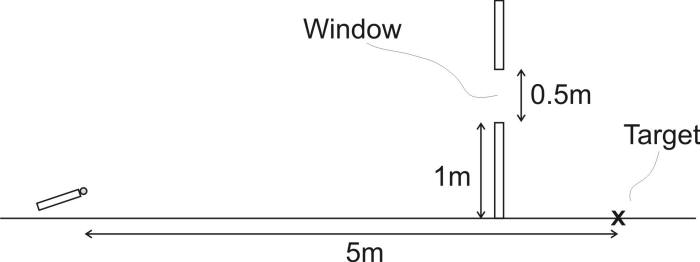 Class 13
Wednesday,
10/3/18
Class 13
Wednesday,
10/3/18Warm Up:
At the angle shown, can the projectile launcher hit the target? If not, how should the launcher be adjusted?
Today:
-
Finish discussing Monday's homework? -- "projectile practice problems 1-4" in Currents and Projectiles -- Notes and Practice (solutions)
-
Continue calibrating launchers. (Directions for calibrating projectile launchers) Create a calibration table and a graph. Check your calibrations by trying to hit targets at a variety of distances.
-
Mini-contest after 30 minutes of calibration time.
-
As a group, begin creating a projectile trajectory simulator (spreadsheet).
-
Here is a link to a Spreadsheet Template that you can use. Given an initial projectile speed and launch angle, your spreadsheet must:
-
Calculate the x and y position of your projectile at incrementally spaced moments during its flight.
-
Provide a graph of y displacement vs x displacement for the entire flight.
-
-
Use this screenshot to confirm that your spreadsheet works correctly. Enter the same values in yellow, and see if you get the same results. Your graph may vary depending on how many data points you include. You may want to add a trend line.

-
For videos showing how to create and fine tune the spreadsheet, see the recent videos on my YouTube channel.
-
Online Textbook (OpenStax) Reading:
Homework:
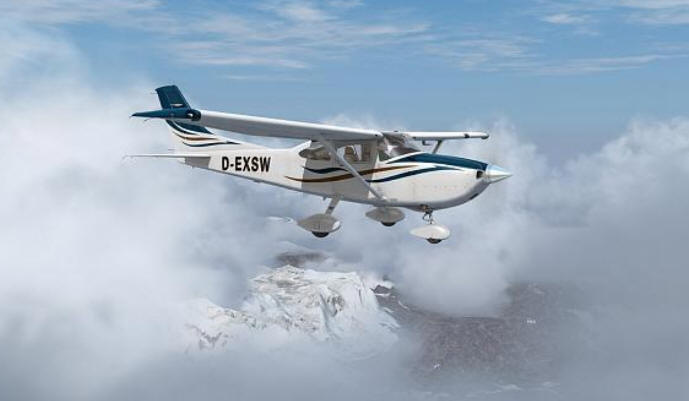 Class 12.5
Tuesday,
10/2/18
Class 12.5
Tuesday,
10/2/18Warm Up:
1. The pilot of a small plane is navigating by pointing her plane directly southward while maintaining an air speed of 100m/s. If the plane has an actual eastward velocity of 50m/s, sketch a velocity vector representing the air velocity.
To eliminate some calculations, you can describe the wind velocity by providing its two component vectors.
2. If there were no windshield, and the propeller were momentarily removed, would the pilot feel air blowing from straight ahead or from some other direction?
Today:
-
Check/Review Homework: "projectile practice problems 1-4" in Currents and Projectiles -- Notes and Practice (solutions)
-
Continue calibrating launchers. (Directions for calibrating projectile launchers) Create a calibration table and a graph. Check your calibrations by trying to hit targets at a variety of distances.
Online Textbook (OpenStax) Reading:
Homework:
- Nothing new. If you're feeling unsure about your understanding of this unit, go back through the previous assignments listed for classes 9.5-10.5 and try to identify the problems or concepts that are giving you the most trouble.
Warm Up: Identify the component and resultant vectors for the following "river problems." Then sketch them using head-to-tail vector addition.
1. A paddler travels eastward at a rate of 3m/s. The paddler's heading is northeastward, and the paddler's speed in still water is 8m/s. What is the velocity of the water in which the paddler is paddling?
2. A quadcopter has a velocity of 20m/s westward. The wind is blowing southward at a rate of 10m/s. What are the quadcopter's airspeed and heading?
3. The driver of a golf cart on an aircraft carrier uses a compass to head northward. The cart's speedometer reads 10mph. The aircraft carrier's heading is eastward, and it's speed in still water is15mph. The ocean current is northwestward at a rate of 5mph. What is the actual velocity (relative to the Earth) of the golf cart?
Today:
-
Check/Review Homework:
-
Initial Velocity Calculator Spreadsheets
-
First page of Chapter 3 Practice Test Solutions
-
-
Trajectory Project: directions for calibrating projectile launchers Create a calibration table.
Online Textbook (OpenStax) Reading:
Homework:
- Complete "projectile practice problems 1-4" in Currents and Projectiles -- Notes and Practice (solutions)
 Class 11.5
Friday,
9/28/18
Class 11.5
Friday,
9/28/18Warm Up:
1. How do you enter a formula in a spreadsheet (e.g. Google Sheets, or Excel)?
2. If you don't know how to do something in a spreadsheet, how can you find out how it's done?
3. How would you create a spreadsheet like the one on the right? Given a projectile's initial speed and launch angle, this spreadsheet calculates the x and y positions of the projectile at any given time.
Today:
-
Return papers: Tests, Corrected Tests, Vector Problems and River Problems
-
Check/Review Homework: 2nd page of Chapter 3 Practice Test Solutions
Coming up:
-
Projectile launcher modification, calibration, and siege contest.
Example problem:
 Example calibration graph:
Example calibration graph:

Online Textbook (OpenStax) Reading:
Homework/Deadlines:
- Tonight's homework:
- Complete the first page of Chapter 3 Practice Test Solutions
- Use Google Sheets to create a spreadsheet like this one
 .
You will have to enter formulas into the blue and green cells.
The purpose of this spreadsheet is to quickly calculate the
initial velocity of a horizontally launched projectile.
The data that must be entered (into the yellow cells) in order
to perform the calculation are initial height and horizontal
distance traveled before hitting the floor. Use the data
in this screenshot to check your formulas. Adjust your share
settings to "anyone at ESWD with a link," and paste your link
into this form.
.
You will have to enter formulas into the blue and green cells.
The purpose of this spreadsheet is to quickly calculate the
initial velocity of a horizontally launched projectile.
The data that must be entered (into the yellow cells) in order
to perform the calculation are initial height and horizontal
distance traveled before hitting the floor. Use the data
in this screenshot to check your formulas. Adjust your share
settings to "anyone at ESWD with a link," and paste your link
into this form.
- All corrections for the first test (1-D Kinematics) must be completed and turned in by Thursday, October 11.
- If you did not get credit for the vector or river problems, you may complete them by Monday for credit. Otherwise they will simply not count. Normally, late homework assignments are not scored, but I am making an exception because of my absence.
 Class 11
Thursday,
9/27/18
Class 11
Thursday,
9/27/18Warm Up : Two canoe paddlers begin at the starting point in the diagram on the right. They paddle with a constant water speed. Paddler A maintains a westward heading while paddler B keeps the canoe pointed at the small island.
1. What is the difference between water speed and speed?
2. Which paddler is following a heading?
3. Describe the shape of the path followed by each paddler.
4. Now suppose we increase the scale of the problem, remove any current, and provide paddler A with a compass only at the beginning of her journey. She points her canoe westward, begins traveling in that direction, and maintains her speed in a perfectly straight path. Assuming that her path is perfectly straight, will she reach the island 1,000 miles away? Explain.
5. What does the previous question suggest about the assumptions of river problems in this class?
6. In this class, river problems will involve three velocities, a) the velocity of a medium (e.g. river water, or moving air) relative to the Earth, b) the speed of an object relative to the medium, and its direction (heading), relative to the Earth, and c) the velocity of the object relative to the Earth. Which of these three velocities will be the resultant vector in river problems? [It may be easier to think of these as the current's direction, the object's heading, and the object's actual path.]
Today:
-
Check-in. See what actually happened while I was gone.
-
Turn-in previous nights' homeworks (vectors and river problems). You can just turn in the whole packet. Staple work to the back.
-
Check/review problems 3 and 4 from the Chapter 3 Practice Test Solutions
-
Questions about the river problems?
-
Kinematics equations for constant velocity and constant acceleration, and when to use them
Coming up:
-
Projectile launcher modification, calibration, and siege contest.
Example problem:
 Example calibration graph:
Example calibration graph:

Online Textbook (OpenStax) Reading:
Homework:
- Finish the problems section of Chapter 3 Practice Test Solutions
Work through these notes and problem sets. Please help one another. Also ask Mr. Chase for help. If you sign up for my Flex, he is in the same room (C211/212).
Online Textbook (OpenStax) Reading:
| Schedule | Item | Where to find it | Directions | Solutions Links | Video Links |
| Monday | Drawing and calculating Orthogonal Vectors |
Top cubby
 2nd column from the right. It's part of the big handout from last week |
|
(Solutions) |
Video:
Intro to 2-D Kinematics and Vectors Vector Addition (drawing and calculating orthogonal and non-orthogonal) |
| Monday | Drawing and Calculating Non-Orthogonal Vectors | Top cubby. Part of big handout from last week |
|
(Solutions) | See above |
| Monday night homework | Classic River Problem | Top cubby. Part of big handout from last week |
|
Solution | |
| Tuesday (Full block) -- and Tuesday night, if necessary | Still more river problems #2-5 | Top cubby. Part of big handout from last week |
|
2017
Solutions to Still more river problems -- with tables Old solutions (no tables) -- (solutions 2-3) (solutions 4-5) |
#5 video #4 video #2 and 3 video -- old solutions |
| Wednesday (split block) | Currents and Projectiles -- Notes and Practice Problems | 2nd cubby from the top. |
|
Filled-in notes and solutions | Video of Notes from Class |
| Wednesday (finish at home) | Chapter 3 Practice Test | 3rd cubby from the top |
|
Solutions | Ch3 PTest Conceptual Questions Video Ch3 PTest Probs 1-2 Video Ch3 PTest Probs 3-4 Video |
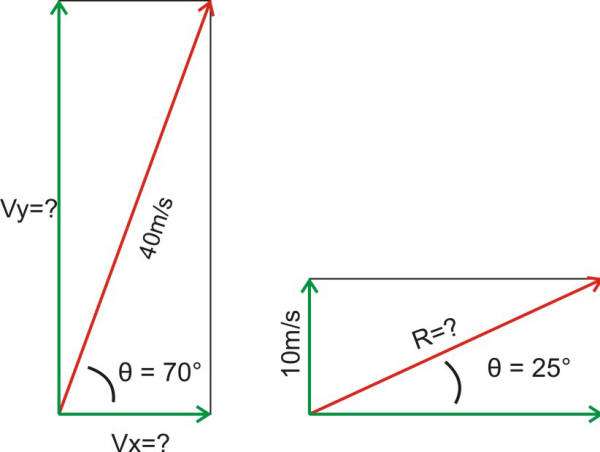 Class
9 Friday,
9/21/18
Class
9 Friday,
9/21/18Warm Up :
1. What are sine, cosine, and tangent?
2. Find the missing vector magnitudes on the right.
Today:
- Mr. Stapleton will be gone on Monday through Wednesday. I will leave problems, solutions, and videos on this website. There will be paper copies of the problems and questions in the classroom, in the wooden cubbies in the front of C209, 2nd cubby column from the right.
- Preview of this unit -- What's on the Chapter 3 Test
-
Vector Addition --Head to Tail Method
-
How to do it:
- Draw all vectors pointing in their proper directions and with lengths proportional to their magnitudes.
- Arrange all component vectors head to tail, to create one big, crooked vector. Replace the crooked string of component vectors with one resultant vector. The head of the resultant vector touches the unpaired head of the component vectors. The tail of the resultant vector touches the unpaired tail of the component vectors.
- Combined handout with notes, analytic vector practice, and river problems (all three of the handouts below)
- Brief vector notes Answer Key
- Analytical (trig and geometry) vector addition practice. Draw and label component and resultant vectors. Measure and label angles of non-orthogonal vectors.
-
How to do it:
Online Textbook (OpenStax) Reading:
Homework:
- There will not be explicit notes on every aspect of vector addition, but we will practice it. In lieu of complete notes, refer to the textbook sections.
- Finish Analytical Vector Addition Practice -- orthogonal and random vector assignments (above)
Warm Up:
1. Suppose the two vectors on the right represent two forces acting on the clam. In what direction will the clam accelerate? What will be the magnitude of the net force accelerating the clam in that direction?
2. The diagram on the right shows a top view of a train car that is moving at a rate of 2m/s. You are in the car. In which direction and how fast should you walk in order to have the intended velocity shown on the right.
Today:
- Return tests -- take a look. Grade distribution.

- PowerSchool grades are updated.
- New unit -- 2-D Kinematics
- Combined handout with notes, analytic vector practice, and river problems (all three of the handouts below)
- Decades songs?
- Brief vector notes Answer Key
Online Textbook (OpenStax) Reading:
Homework:
Warm Up: No warm-up today
Today:
- Test, 1-D Kinematics
Online Textbook (OpenStax) Reading:
Homework:
 Class
7.5 Tuesday,
9/18/18
Class
7.5 Tuesday,
9/18/18Warm Up:
1. Propose an explanation for why this velocity graph is so scattered looking.
2. What five variables should you look for in kinematics problems?
Today:
- I finished reviewing and making comments on the video analyses (A5/6, A7/8) . If you have a yellow cell, you must redo whatever is yellow. Otherwise, making corrections is not mandatory.
- Completion of the video analysis is required, unlike ordinary homework. If you have not submitted analysis videos and graphs, you may still do it for credit.
- Check/review 1-D Kinematics Practice Test #2. Solutions and "More Kinematics Problems" Solutions
Homework:
- Test tomorrow. Bring a pencil and a calculator.
 Class
7 Monday,
9/17/18
Class
7 Monday,
9/17/18Warm Up:
1. Eliud Kipchoge ran 26.22 miles in a time of 2:01:39. What was his average Δt, in minutes and seconds, for each mile?
2. Why is a marathon 26 miles, 385 yards?
3. Take a look at the formulas that you will be given on the test.
Today:
- Unit Conversions Practice -- A couple of examples
- Check/review extended problem in 1-D Kinematics Practice Test #2. Solutions
- Finish practice test 2, plus #58 and 59 from "More Kinematics Problems" Solutions
Online Textbook (OpenStax) Reading:
Homework:
- Finish 1-D Kinematics Practice Test #2. Solutions and "More Kinematics Problems" Solutions
-
Test on Wednesday:
- Format: 2 short answer (4pts total), 14multiple choice (14 points), 1 unit conversion problem (2pts), 5 one-part problems (20pts), 1 extended problem with 6 parts (12 pts). 52 points in all, worth at least 80% of your grade as of Thursday.
- Topics on the test: What it can mean to have different combinations acceleration (+,-, or 0) and velocity (+,-, or 0); graphing; free-fall; unit conversion; problems (identifying variables and applying correct formulas), including proper units, showing work for partial credit, formulas for average velocity and acceleration
- What to study: notes, homeworks (including Mr. Pennington's old test), practice test. Video analysis will not be on the test.
 Class
6.5 Friday,
9/14/18
Class
6.5 Friday,
9/14/18Warm Up:
Sometimes people celebrate special occasions by firing guns into the air.
1. Is this a dangerous way to celebrate? Why, or why not?
2. Why don't clouds fall out of the sky?
Calculated terminal velocities of various spheres.
Today:
- Unit Conversions Practice -- A couple of examples
- Check/review homework #2 of Extended Kinematics Problems Answer Key, #57 and #60 from "More Kinematics Problems" Solutions
- 1-D Kinematics Practice Test #2. Solutions
Online Textbook (OpenStax) Reading:
Homework:
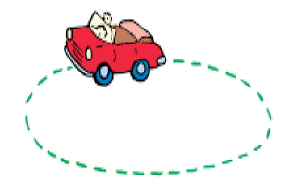 Class
6 Thursday,
9/13/18
Class
6 Thursday,
9/13/18Warm Up:
1. A race car is traveling counterclockwise around a circular track. The car's speedometer stays on exactly 100mph the whole time.
Describe what happens to each of the following as the car makes one revolution around the track:
a ) the car's speed b) the car's velocity c) the
car's acceleration.
) the car's speed b) the car's velocity c) the
car's acceleration.
2. All of the speed calculations in the screenshot on the right (blue) are slightly off, and the last speed calculation (red) is really, really off. Why?
Today:
- Announce Women Can Do conference
- Check/review homework Complete #1 of Extended Kinematics Problems Answer Key
- Watch some videos and check out their graphs (A5/6, A7/8)
- Work time
Coming Up:
- Friday -- 2nd practice test (includes an extended problem)
- Monday -- Review 2nd practice test
- Wednesday -- Chapter 2 Test -- 1-D Kinematics
- Some day (probably) -- Quiz over video analysis
Online Textbook (OpenStax) Reading:
Homework:
Warm Up:
Match each position vs. time graph with the correct velocity and acceleration graph.
Today:
- Announce Women Can Do conference
- Check/review homework Mr. Pennington's Old 1-D Kinematics Test Answer Key.
- Take a quick look at the video analyses (A5/6, A7/8) -- watch some videos tomorrow.
Coming Up:
- Thursday -- watch some videos, more practice problems
- Friday -- 2nd practice test (includes an extended problem)
- Monday -- Review 2nd practice test
- Wednesday -- Chapter 2 Test -- 1-D Kinematics
- Some day (probably) -- Quiz over video analysis
Online Textbook (OpenStax) Reading:
Homework:
- Optional Homework in case you want unit conversions practice -- Unit Conversions Practice
- Complete #1 of Extended Kinematics Problems Answer Key Video showing how to solve the problem
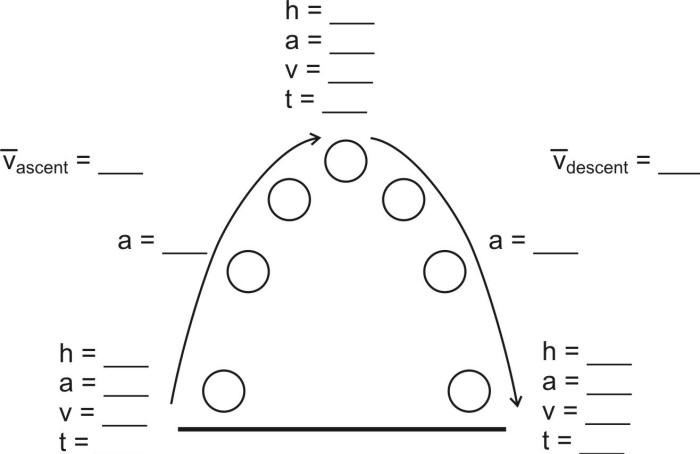 Class
5 Tuesday,
9/11/18
Class
5 Tuesday,
9/11/18Warm Up:
A ball is launched directly upward from the Earth's surface. The ball returns to Earth and hits the ground after a time of 10 seconds. Assuming no air resistance and g≈10m/s2, fill in the values in the diagram on the right. [Though the diagram appears to show horizontal motion, assume that there is none.]
Today:
- Check/review homework Mr. Pennington's Old 1-D Kinematics Test Answer Key.
- Work time:
- Mr. Pennington's test -- solve the problems
- Remember that, on a test, you may receive partial credit for: Useful Equation(s), correct identificaton of all given variables, math/computation, reasoning, units
- Finish video analyses
- Mr. Pennington's test -- solve the problems
Online Textbook (OpenStax) Reading:
Homework:
- Due tomorrow: Complete the problems section of Mr. Pennington's Old 1-D Kinematics Test Answer Key.
- Video Analysis is due tomorrow
-- Complete your row of your class' spreadsheet (A5/6,
A7/8).
- Make sure that everything (videos and spreadsheets) are shared with "anyone with a link."
- Fix your motion graphs so that they correctly represent the motion from your video.
 Class
4.5 Monday,
9/10/18
Class
4.5 Monday,
9/10/18Warm Up:
The symbol "g" usually represents the absolute value of the acceleration of gravity near Earth's surface (in the absence of air resistance). The approximate value of g is 9.8m/s2.
For the sake of simplicity, use g = 10m/s2 to complete the motion graphs for an object with v0 = 20m/s and y0 = 0m.
[Ignore air resistance.]
Today:
- Brief demo -- how to use formulas in a spreadsheet.
- Finish individual video analysis work:
- Choose two videos to analyze. One must use the stationary camera method (Logger Pro Method), and one must use the moving camera method (Quicktime).
- Click one of these links to your class spreadsheet -- A5/6, A7/8
- Enter your name on the next open row. Insert links to your videos into columns C and G. Enter descriptions of what the video is supposed to demonstrate into columns B and F.
- Use the Logger Pro (stationary camera) method first, following the Video Analysis Directions. You should use Logger Pro first because you probably will not have access to Logger Pro at home. Quicktime player, on the other hand, is fairly easy and free to download.
- Analyze another video without using QuickTime (motion along a ruler). To make your task easier, feel free to copy these spreadsheetsand modify them to meet your needs (Logger Pro method, Quicktime Method).
- Video Links showing how to analyze videos using both methods -- created last year.
Tomorrow:
-
Review homework
-
?
-
Work time:
-
Extended problem(s)
-
Wrapping up video analysis?
Online Textbook (OpenStax) Reading:
Homework:
- Due tomorrow: Complete the multiple choice section of Mr. Pennington's Old 1-D Kinematics Test Answer Key.
- Video Analysis is Due on Wednesday
-- Complete your row of your class' spreadsheet (A5/6,
A7/8).
- Make sure that everything (videos and spreadsheets) are shared with "anyone with a link."
- Fix your motion graphs so that they
correctly represent the motion from
your video. In cases where your video was
rotated sideways in Logger Pro, you may use formulas to fix the
data or you may resolve the confusion with creative y-axis
labeling. For example, if your video shows a dropped ball,
but the video is rotated counter-clockwise, so that the ball
seems to accelerate positively to the right, you may label your
velocity graph y axis with the following statement "speed in the
direction of the ground (meters)." For objects with
diagonal motion, you will need to specify which component of the
object's motion is being represented, so your y axis might be
labeled "upward speed," "downward speed," "rightward speed," or
"leftward speed." If you want a challenge, you could use
formulas to calculate the actual diagonal speed based on the x
and y velocities, using the pythagorean theorem.
 Class
4 Friday,
9/7/18
Class
4 Friday,
9/7/18Warm Up:
1. For letter a, on the right describe what an object could be doing in order to have both positive velocity and positive acceleration.
2. Do the same for the rest of the letters.
Today:
- A7/8 -- finish going over #7 and #8 from Wednesday's homework. Answer Key -- Kinematics Formulas and Practice Problems
- Demonstation of how to complete video analyses. Falling object Rubber Band Car
- Video Links showing how to analyze videos using both methods -- created last year.
- Begin
analyzing motion videos.
- Upload Videos to your Google Drive
- Set your shared settings so that anyone in the district can view the videos.
- Share the videos with your group, or send them links.
- Individual Work:
- Choose two videos to analyze. One must use the stationary camera method (Logger Pro Method), and one must use the moving camera method (Quicktime).
- Click one of these links to your class spreadsheet -- A5/6, A7/8
- Enter your name on the next open row. Insert links to your videos into columns C and G. Enter descriptions of what the video is supposed to demonstrate into columns B and F.
- Use the Logger Pro (stationary camera) method first, following the Video Analysis Directions. You should use Logger Pro first because you probably will not have access to Logger Pro at home. Quicktime player, on the other hand, is fairly easy and free to download.
- Analyze another video without using QuickTime (motion along a ruler). To make your task easier, feel free to copy these spreadsheetsand modify them to meet your needs (Logger Pro method, Quicktime Method).
Online Textbook (OpenStax) Reading:
Homework:
- If you want some clarification on how to analyze the videos, check out these YouTube videos.
 Class
3.5 Thursday,
9/6/18
Class
3.5 Thursday,
9/6/18Warm Up:
1. How does the Amazing Water and Sound Experiment work?
2. Answer to yesterday's warm-up#3?.
Today:
- Enter attendance
- Check/review homework -- Answer Key -- Kinematics Formulas and Practice Problems
Online Textbook (OpenStax) Reading:
Homework:
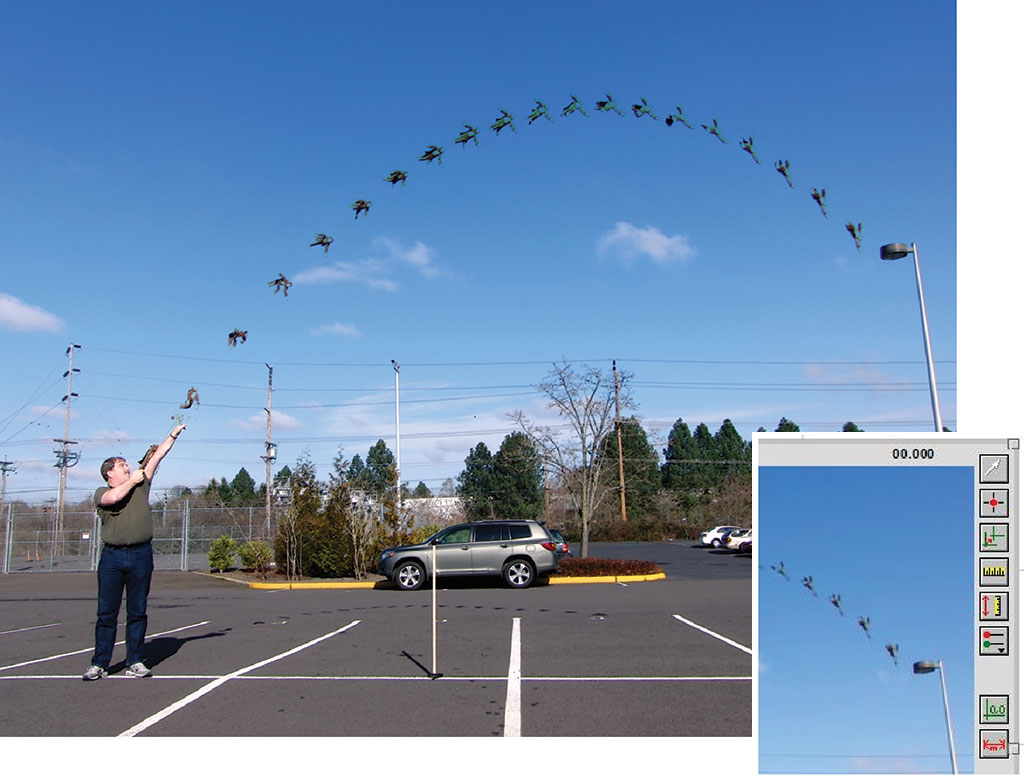 Warm Up:
Warm Up:
1. Assuming that the man in the picture is 2m tall, and the frame rate of the camera was 30 frames per second, what were the approximate maximum and minimum speeds of the object?
2. Based on your answers, do you think the assumption of 30 frames per second was too loww, too high, or about right?
3. If you could travel in time, and you found yourself in the infinite loop of acceleration changes shown below... a) what might your velocity and position graphs look like?, and b) would you ever find yourself in the same location as another past self? If so, show how this could occur.

Today:
- Enter attendance
- Notes: Intro to Kinematics Formulas Answer Key -- Kinematics Formulas and Practice Problems
- Begin
Motion Video Scavenger Hunt
- Create Videos
- Transfer videos to a school computer. Name them something descriptive and helpful.
- Upload Videos to your Google Drive
Online Textbook (OpenStax) Reading:
Homework:
- Complete Problems #1-8 in
Notes: Intro to Kinematics Formulas. Answers:
1. -63.8m/s 2. 40mph 3. -78.4m/s
4. 350m 5. -0.4m/s^2 6a. -2.81m/s^2
6b. 5.34s 7. 13.3m/s 8. -4.44m/s^22
- Trade any two of these problems for the #3 warm-up problem, above.
- Answer Key -- Kinematics Formulas and Practice ProblemsAnswer Key -- Kinematics Formulas and Practice Problems
Warm Up:
A runner sprints exactly 100m, rests for a moment, and then slowly follows the same path back to the starting line. This entire trip takes 200s. For the questions below, consider the runner's entire round trip.1. What distance did the runner travel?
2. What was the runner's displacement?
3. What was the runner's average velocity?
4. What was the runner's average speed?
Today:
- Check/review homework 1-D Kinematics notes 1-D Kinematics notes Answer Key Graph Comparisons Graph Comparisons solutions
- Notes: Kinematics Formulas and Practice problems Answer Key -- Kinematics Formulas and Practice Problems
- Motion Video Scavenger Hunt
Handouts:
Online Textbook (OpenStax) Reading:
Homework:
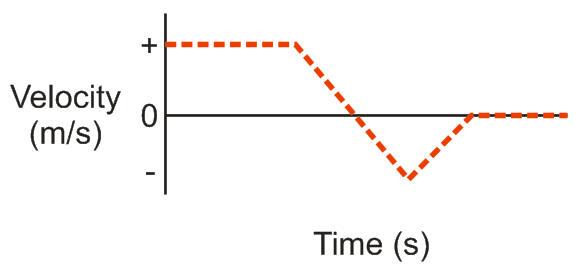 Class
2 Friday,
8/31/18
Class
2 Friday,
8/31/18Warm Up:
Use the velocity vs time graph on the right to sketch the shape of a corresponding position vs time graph.
[Hint: positive velocity corresponds to movement away from a motion sensor.]
Today:
- Fill out Student info sheet
- If you arrive late, make sure that I change your status in Powerschool.
- Turn-in signed course expectations
- Preview a practice test? Based on last year's pace, the first test will be around 9/18.
- Complete 1-D Kinematics notes 1-D Kinematics notes Answer Key
- Complete Acceleration Notes -- Answer Key
- Work time
Handouts:
Online Textbook (OpenStax) Reading:
Homework:
- Course expectations signatures.
- Complete #5-8 in 1-D Kinematics notes 1-D Kinematics notes Answer Key
- Complete Graph Comparisons Graph Comparisons solutions
.JPG) Class
1.5 Thursday,
8/30/18
Class
1.5 Thursday,
8/30/18Warm Up:
For each letter, describe what is happening to the person's speed and direction during the 10 seconds represented on the graph.
Today:
- Enter attendance
- Turn-in signed course expectations
- A7/8 -- hand out 1-D Kinematics notes 1-D Kinematics notes Answer Key
- Go over motion matching questions
- Quickly run through course expectations
- Stapleton slideshow
- Student info sheet?
Handouts:
Online Textbook (OpenStax) Reading:
Homework:
- Course expectations signatures.
- Suggested Reading (see above)
Physics 200: Mr. Stapleton
Warm Up:
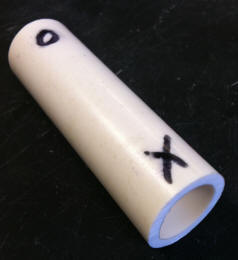 Spin
one of the "sprotating cylinders" by pressing one end until it squirts
out from under your finger. Try pressing the other end.
Spin
one of the "sprotating cylinders" by pressing one end until it squirts
out from under your finger. Try pressing the other end.
When the cylinder is spinning, why do you only see the symbol that you press?
Today:
- 8 students log in to desktops ASAP
- Learn names/pronunciations
- Enter attendance
- Student info sheet
- Mr. Stapleton philosophy, slideshow, etc
- Briefly go over course expectations, class overview (see last year's site).
- Motion Matching Activity -- at rink?
- Directions: Matching Motion Graphs with motion detector (Web page)
- Answer questions a the end of the velocity notes
- ***A5/6 has D lunch.
- B-Day Split block times (I think) are:
- B5 -- 1150-12:28
- B6 -- 12:32-1:10
Handouts:
Online Textbook (OpenStax) Reading:
Homework:
- Get your course expectations signed and then return them.
- Suggested Reading (see above)



